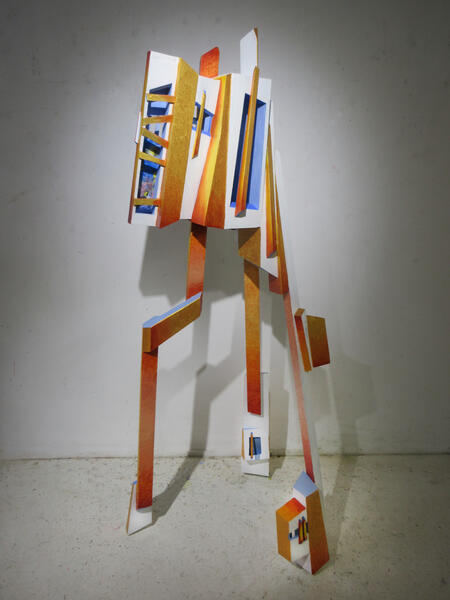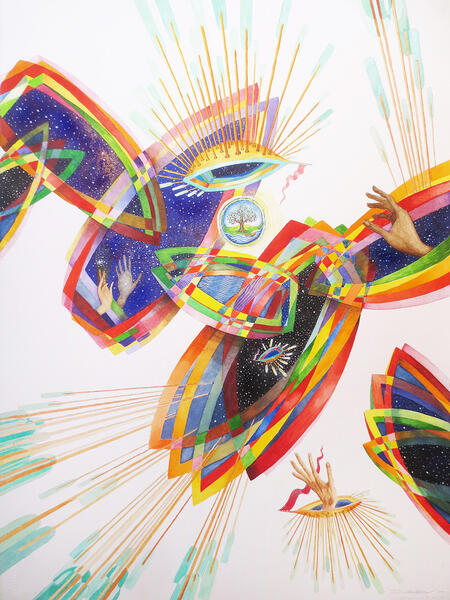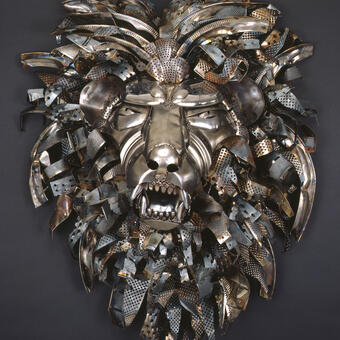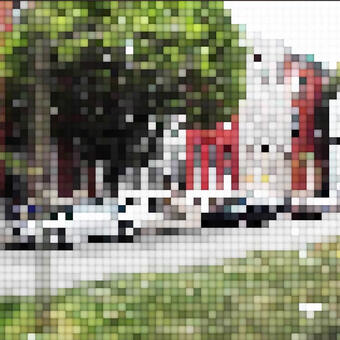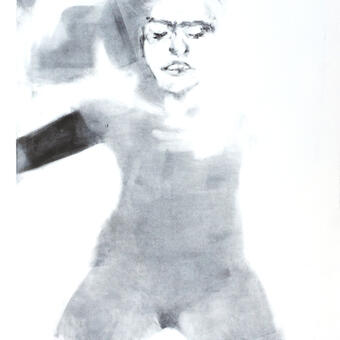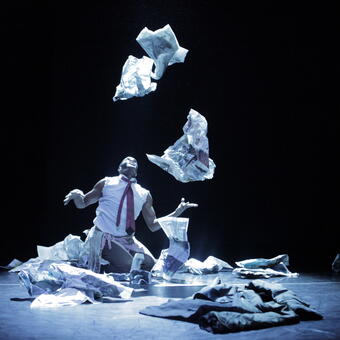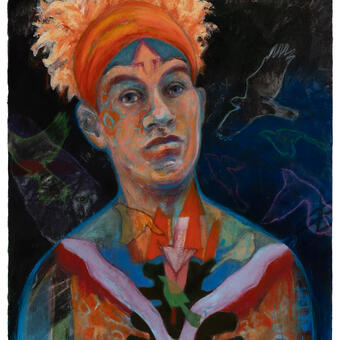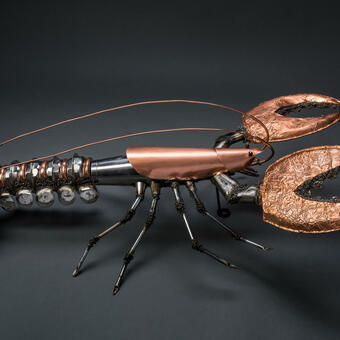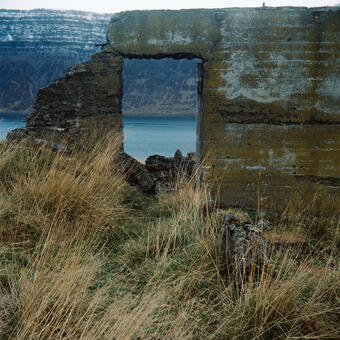Work samples
-
Turnaround
Turnaround is a key part of an ongoing series of wrapped sculpture initiated twenty years prior. Most are wall mounted.
Available for Purchase$8000. Contact the artist: [email protected]
-
The Decade of Pey
The Decade of Pey (the Mouth): 2021- 66" x 60" x 12"d- The shield is the top of the bow of a 19th century sailing skiff destroyed in my garden by a runaway car. Acrylic. Wood canoe paddle painted with stars. The central ring is composed of carved, laminated hardwoods. The blue center is linticular foil symbolizing water.
Available for Purchase$10,000.00
About A
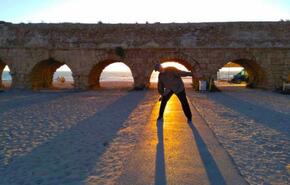
I was raised on the post WW2 western Pacific island of Guam from 1952 to 1963. It was a paradise of extremes, from the glorious treasures of the ocean, to giant coconut crabs and the lavish fiestas where all races were welcome. In contrast, hidden bombs and hand grenades were still being tripped over and killing people years after the war. However, it was the typhoons that devastated Guam five times that caused us to return to America. Following three transformative years in Long Beach… more
The Floating Axe series
Names often reflect key aspects of our character. My last name, Zaruba is an old Czech name that loosely translates as 'he who splits wood with an ax'. As Allen means harmonious, then I am the happy woodcutter. Yet, years before I discovered this, I was intuitively drawn to wood as a creative expression, even during the 20 years when painting was my principle medium.
As a consequence, the symbolism of the ax has periodically appeared in my sculptural work. This began with acquiring an eroded ax head in 1991 that had lay buried in a 200 year old apple tree. I gilded it's lace-like form in 24k to translate the way I perceive it's context and resonance. The hollow of the handle suggests a house in miniature, such as the spirit houses of Asian cultures or the sky burials of others. Later this concept inspired two series of cage-like sculptures on legs during the 1990's based on human rights abuses.
During a 2015 residency in West Cork, Ireland, I participated in a fascinating annual bronze casting symposium, Umha Aois, which attracts artists and archeologists who utilized the basic techniques, raw materials and processes of the bronze age to produce new works, some of which were replications of historic artifacts, such as the ax. This was the catalyst that prompted the series.
This series began with Awakening , which, in turn, followed the series-A Tent of Stars. Based upon the ax as metaphor and symbol, this initial 'ax' surface is covered in stars with a 3D form as flame that passes through a small canoe covered in lenticular image fragments of various works of art and cultures. The upper hollow is lined with slices of lenticular images and reflective surfaces.
Why the ax?
Considering the increasing cultural violence as well as our tendency to isolate ourselves through social media, I was initially at a loss as to why I would focus on what most Americans would peg as a weapon of violence, such as the Lizzie Borden murders. The research helped me to see that the ax symbolizes much that is positive and constructive, especially in regards to the building of civilization. Yet, the symbol, like a mirror, confronts us with what is buried in our own make-up.
The ax is an ancient universal symbol of authority and power rooted in many cultures, from the First Nations to Asian, European and African cultures. For example, in ancient China, the ax symbol was often woven into the silk robes of the emperors to signify the decisiveness of their absolute imperial authority. From there, I began to explore other cultural myths which led to the foundation that the first axes were stone. These created sparks and consequently became associated with lightning, thunder, rain, rebirth and...creation! They were often termed 'thunderstones' and held as highly sacred. It is interesting to note that both the Chinese and Pre Colombian cultures periodically created elaborate, non-functional ceremonial axes out of prized jadite and flint.
The metaphor of the ax can operate on many levels, such as splitting apart issues to reveal 'facts' or the truth. The ax is judgment in action, splitting truth from lies, clarity from confusion. It is both tool and weapon. My hope is that the abstraction of the symbol would offer a way of considering how each of us might see authority (vs. the current focus on abuse and fear.), possibly as a way to reflect more deeply upon what our culture is contending with. Above all the mud slinging, what is true? What are the facts? What vital aspects may be missing? Do we believe everything we are fed by the media? Are we selective in the building of our own 'false news' campaign? What do we not want to consider or see?
Gilding the blade edges with 24k gold questions what is eternal against the brevity of life. The moment of now is now past. Getting into the river now is not the same river tomorrow. Gold's stability is a fascinating medium, especially as it is the only metal that visible light can pass through and yet filter out those rays that can harm our eyes. It has been used in the visors of pilots and astronauts to protect their vision.
-
Awakening96"h, Based on studies of bronze age Chinese ax heads. Acrylic, carborundum, lenticular image fragments and mixed media collage on wood with 24k gilding, swarovski crystals. The upper chamber (behind the orange facade) contains vertical slices of lenticular image fragments, acrylic mirror and treated Mylar.
-
Life Raft24"h x 13"w x 3"d, wood, synthetic ink, 24k gold leaf, lenticular fragment of Earth and the moon.
-
Skin Scraper24"h x 13"w x 2.5"d- Synthetic ink on acrylic on wood, lenticular image of Venus, 24k. In ancient China, anything that was yellow automatically became property of the Emperor. Yet the emotional play of yellow in contemporary culture has very different associations.
-
Est ad Astra23"h x 12"w x 4"d Acrylic on burned wood, pen shell fragments, titanium exhaust port, lenticular fragment of stars.
-
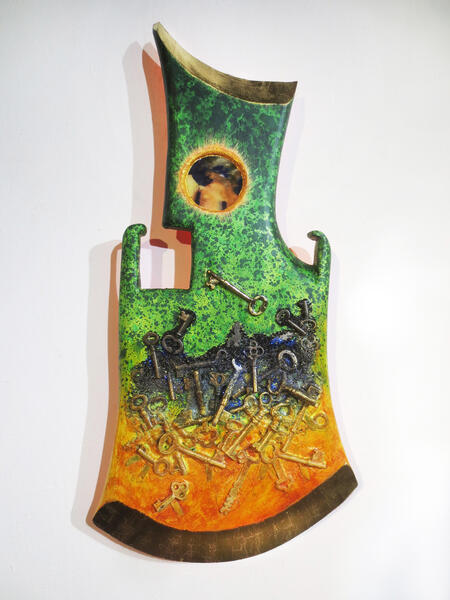 The One True Key23"h 11"w x 2"d, acrylic, antique keys, slag crystals. Lenticular image of Israel and the Middle East (from space), 24k gold leaf
The One True Key23"h 11"w x 2"d, acrylic, antique keys, slag crystals. Lenticular image of Israel and the Middle East (from space), 24k gold leaf -
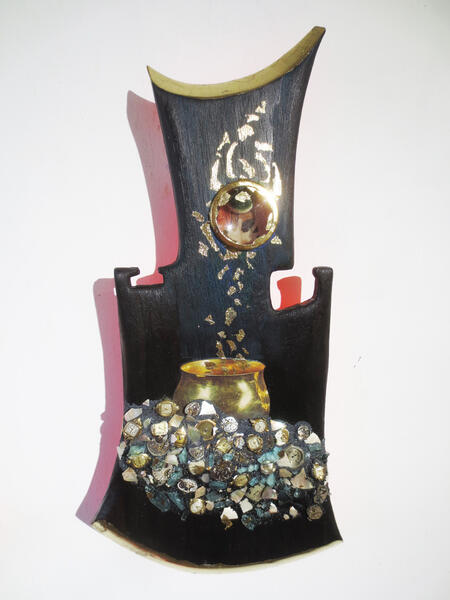 Out of Time22"h x 11"w x 3"d, burned wood, photo collage, 24k gold leaf, antique women's watches, auto glass, mother of pearl, magnifying lens, lenticular fragment, operculeum.
Out of Time22"h x 11"w x 3"d, burned wood, photo collage, 24k gold leaf, antique women's watches, auto glass, mother of pearl, magnifying lens, lenticular fragment, operculeum. -
Cry: Out of the Fire30"h x 23"w x 2"d: Acrylic and mixed media on wood with 24k leaf
-
The Sacrifice26"h x 12"w x 3"d, acrylic on wood, copper, zippers, stones, 24k gold leaf, lenticular fragment of Jupitar's moons.
Recent Works
As of 2025, for decades my work continues to be in a state of questioning flux. Along with creating new series, I often revisit and change older key works again and again, sometimes over a decade or two. This happens as my concepts evolve and I see how to refine and bring such into a greater coherence. At any given time, I'm working on as many as 7 to 8 different series. On rare occasions, I've destroyed or dismantled major works, either because of a lack of storage or them being in public parks.
As my concepts are born out of living among and exploring diverse cultural and social influences, I foster a free-ranging, intuitive approach to making work that doesn't follow a set of rules, let alone the fashions of the art world. So, my work is notable for its wide range of differing series, shifting from sculpture to painting or a combination of diverse media. Yet, there are interconnecting key spiritual themes that drive my work. The great Russian film director, Andrei Tarkovsky tagged one key as "the dilemma of the human condition".
I'm often surprised amid my process, which is fermented by many internalized questions, such as "What am I seeing or not seeing? Is this authentic or flatulence?" Yet, it is never to mount a soap box, but rather to offer visual encounters that transcend cultural expectations through a positive lens.
My diverse visual sensibility filters a color driven, abstracted tactility initially based upon my jungle experiences in Panama and the Philippines, while working in military intelligence. Even now, I tend to cycle through periods of stripping down to essentials to complex layering. Few works are singular while most become prototypes for further work. Some series number as low as three, yet others have resulted in as many as 60.
I love reworking pieces when i see a greater potential. In turn, when I dismantle certain works I make use of the resulting fragments. This continues to teach me the power of resurrection, where something that was solid or even good, gains more than what it had before.
-
The Four Faces- 7/2025
Linticular fragments on wood with acrylic
Available for Purchase$3000. plus shipping and insurance in advance.
-
Warrior1-2020: 58"h x 46"w Acrylic painting on paper on canvas
-
Ascent1-2020 73"h x 43"w Acrylic on giclee print on canvas.
-
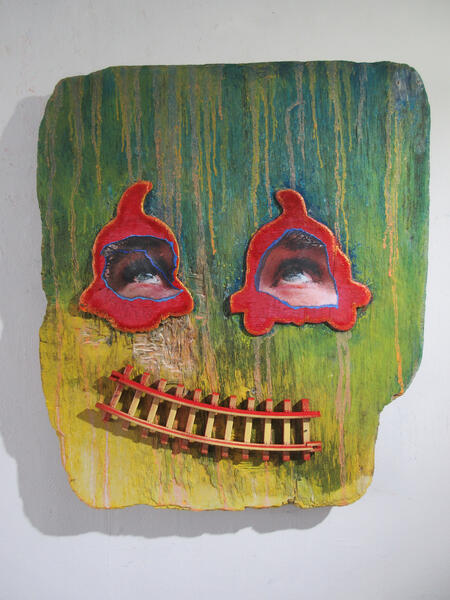 One Track28" h x 22"d, Acrylic, paper and cast resin on weathered wood
One Track28" h x 22"d, Acrylic, paper and cast resin on weathered wood -
StardustStardust- not resolved yet- 48"h, acrylic on wood. Crystals
Abstractions and Metaphors
Among our global challenges I'm often inspired by the intersections of science and culture, where so called 'facts' and the deeper mysteries within us collide. Hence my 'non-liniar' output. My aim is to create works which raise questions from the invisible through abstractions and metaphors. Being intuitive, I play with hints, suppositions and the margins of being as I go after the mystery. Can truth become a formula or does it die when placed upon a forced march by external demands?
For example, scientists are speculating that it might be possible for something to be bigger on the inside than it is on the outside. Aspects of popular culture has long promoted this concept, such as Dr Who's Targis, Mary Poppin's bag, Felix the Cat's magic bag of tricks and many others. Jules Verne's and George MacDonald's books fortold these days. We are all really children pretending to be adults.
Scientists are saying that some 'regions' of spacetime have that property. Indeed, the concept of redeeming your timeline is beginning to emerge. Is the space time continuum flexible, even fluid to change?
Since my youth I've been a stranger on a strangely beautiful world. The deeper mysteries of creation pose far more questions than proven facts. That drove me into life changing books, such as Buckminster Fuller's Ideas and Intengrities and George Steiner's Language and Silence.
What may appear to be contradictions are important, as they can lead us to greater truths. For example, decades ago I worked in military intelligence in the midst of the Vietnamese refugee crisis in the Philippines. My hidden work led to being selected for the Blue Angels flight team for four very public years. It became an explosive shift in my identity and ideas! As a consequence, my work was briefly exposed to a global audience and a fat head for a time.
Yet all of that fell away after leaving the military. Then, I entered another radical shift when I was in NYC on the art scene's fast track, where I found the scene to be more prediatory than Panama's jungles. After a year, I bypassed a budding international career and returned to Baltimore. My collectors thought I'd lost my mind. Yet, more and more I needed the space and peace and serenity of my half acre of gardens to regather my wits and my integrity.
At that time I was facing many self-contradictions. Gradually I softened my relentless self promotion and the toil of shows in order to be free and push into a deepening exploration. After a few testy years, I began to connect those contradictions and realized there was an arc building towards a coherent understanding. In creating unique bodies of work, I gained a freedom moving between 2-D to 3-D to performances and videos and back. A more authentic confidence emerged.
-
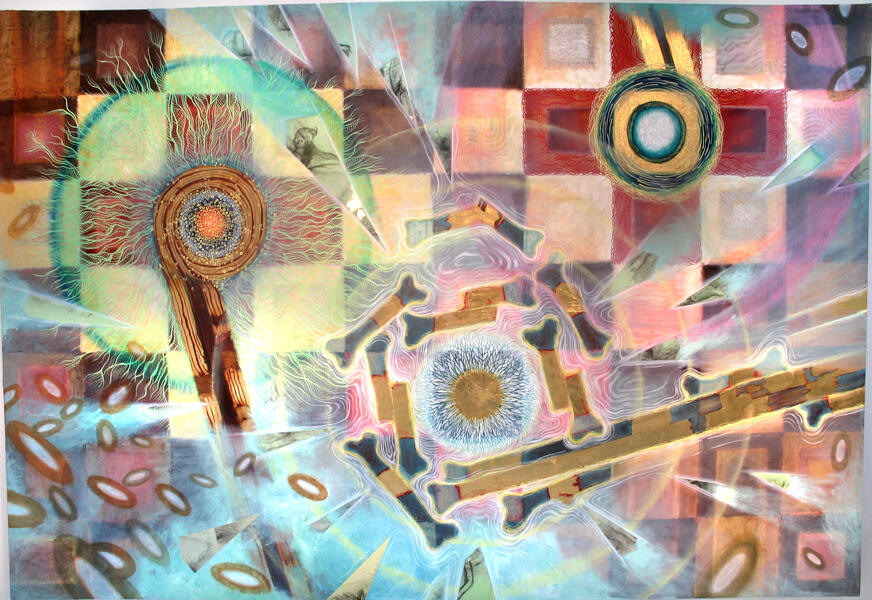 Up From the Field8 feet wide. Oil on canvas, w/24k and linticular images. Based on the Book of Ezekiel and the valley of dry bones.
Up From the Field8 feet wide. Oil on canvas, w/24k and linticular images. Based on the Book of Ezekiel and the valley of dry bones. -
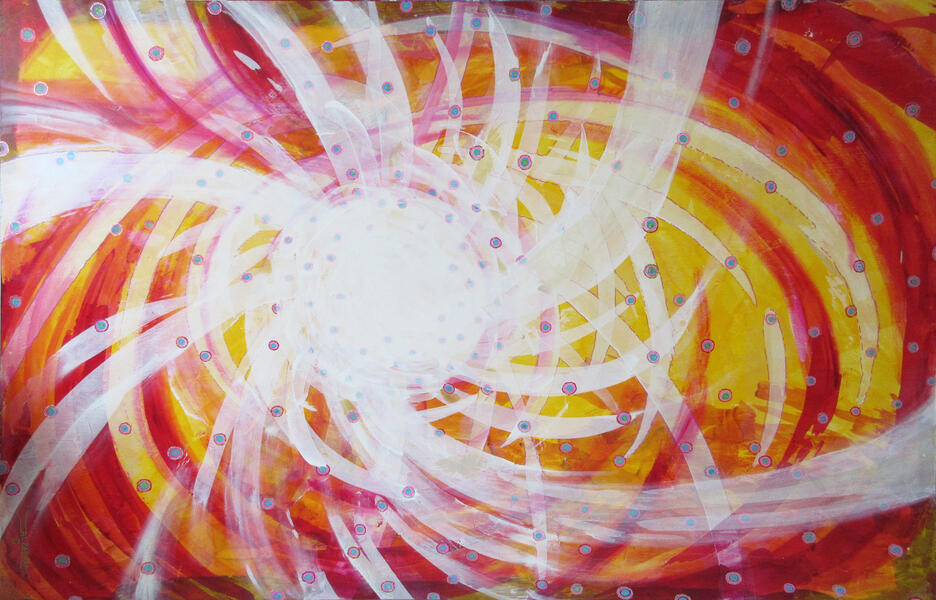 Song of the DoveSong of the Dove: 7/2021- 4' x 6'- acrylic on mounted wood.
Song of the DoveSong of the Dove: 7/2021- 4' x 6'- acrylic on mounted wood. -
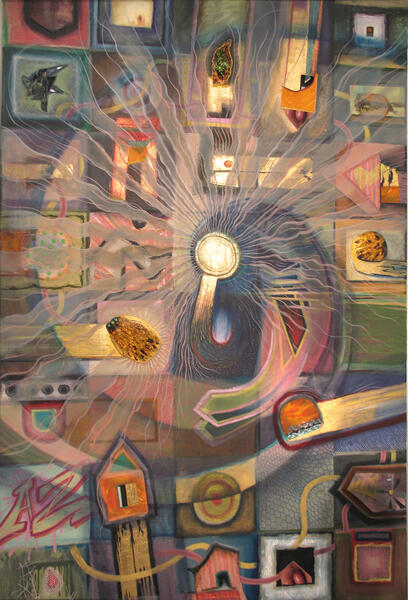 Turnaround2010- Oil on canvas, 24k, linticular images, mixed media seven feet high. What does it matter how an artist comes to such an image? To me, painting is a deeply spiritual journey that is also like a child's sandbox- where the voyage of discovery provides moments of revelation.
Turnaround2010- Oil on canvas, 24k, linticular images, mixed media seven feet high. What does it matter how an artist comes to such an image? To me, painting is a deeply spiritual journey that is also like a child's sandbox- where the voyage of discovery provides moments of revelation. -
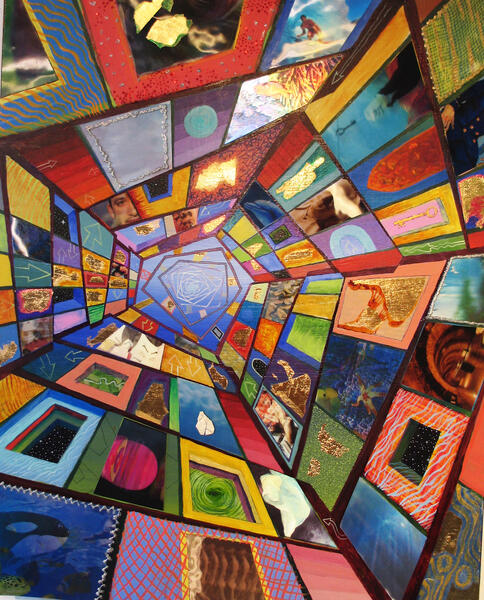 Tower2012- Acrylic on canvas, optical plastics, 24k, turtle shell. Private collection- Hawaii
Tower2012- Acrylic on canvas, optical plastics, 24k, turtle shell. Private collection- Hawaii -
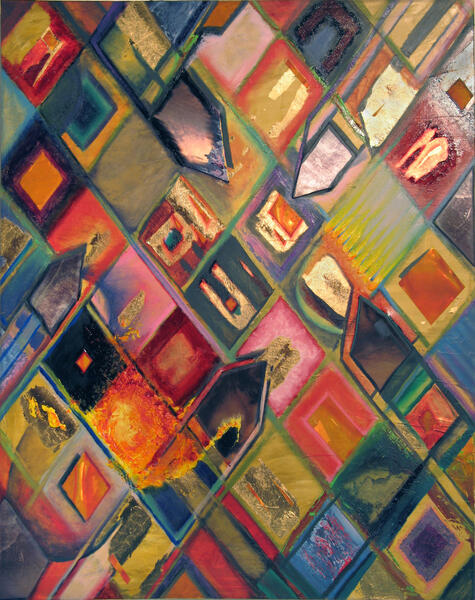 Plunge2010- 30" x 22", acrylic on canvas, with lenticular fragments, 24k
Plunge2010- 30" x 22", acrylic on canvas, with lenticular fragments, 24k -
Dal Profundo: 35 Portals2007- 45"h x 66"w x 3"d, Oil on tar on canvas with 24k gold leaf. Burned wood, crushed metal.
-
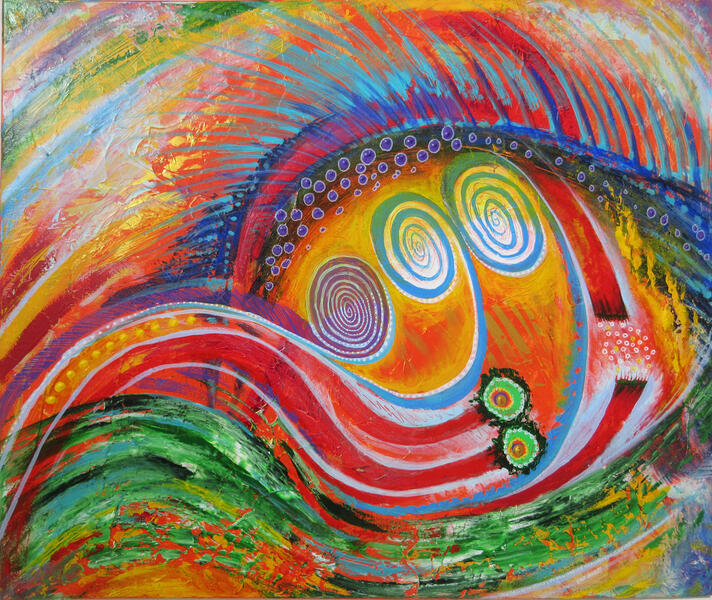 Joy, Joy, JoyJoy, Joy, Joy: 24" x 32", Acrylic on wood
Joy, Joy, JoyJoy, Joy, Joy: 24" x 32", Acrylic on wood -
His Love Endures Forever7/2021: 24" x 32": Acrylic on canvas with glitter
Sculptural Forms and Concepts
Other primary influences include 18 months I served in military intelligence in the Philippines- 1978-80, during the height of the Vietnamese refugee crisis- a horrific time that turned my heart towards the dilemma of the human condition from a universal perspective rather than a cultural or political one. Then in 1988, a critical year in Paris, France and other European cultures. Then beginning in 1990, a radical decade working as the assistant to the Arte Povera sculptor, Salvatore Scarpitta. Sal initially told me- "Allen, you have too many ports of call in your work. Go to the North Pole where nothing is left but the sky above and the snow below."
So typical of Sal to offer such a contradiction that set me on fire- refining down to conceptual abstrations, away from found objects and into complex layers of texture. In turn my own authentic identity began to emerge, free of chasing after a major career or needing to be recognized or shown. Instead I slowed down and drew ever deeper into a spiritual growth , towards a great hope that cannot be denied.
-
TophatPainted wood assemblage- burned and wire brushed barn wood frame, linticular insets, 24k gilding, cast child's hand, walnut shell, etc. The last piece in the Floating Ax series.
-
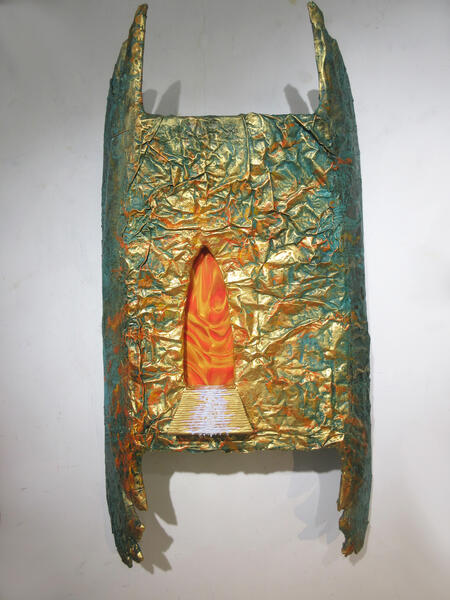 Fire Sled.jpg3-2022- 66"h Weathered copper sheeting over a wood framework. (Salvaged from the hull of the historic USS Constellation in the Baltimore Harbor, during its overhaul several years ago). Acrylic on the sealed, oxidized copper. Inset is lenticular foil. Stairs are wood with acrylic.
Fire Sled.jpg3-2022- 66"h Weathered copper sheeting over a wood framework. (Salvaged from the hull of the historic USS Constellation in the Baltimore Harbor, during its overhaul several years ago). Acrylic on the sealed, oxidized copper. Inset is lenticular foil. Stairs are wood with acrylic. -
Broken MoonBroken Moon-2004. Acrylic on wood, with Korean Chosen Dynasy celadon bowl fragments excavated around Seoul, Korea while serving as a senior Fulbright Scholar to Sung Kyun Kwan University. Private Collection
-
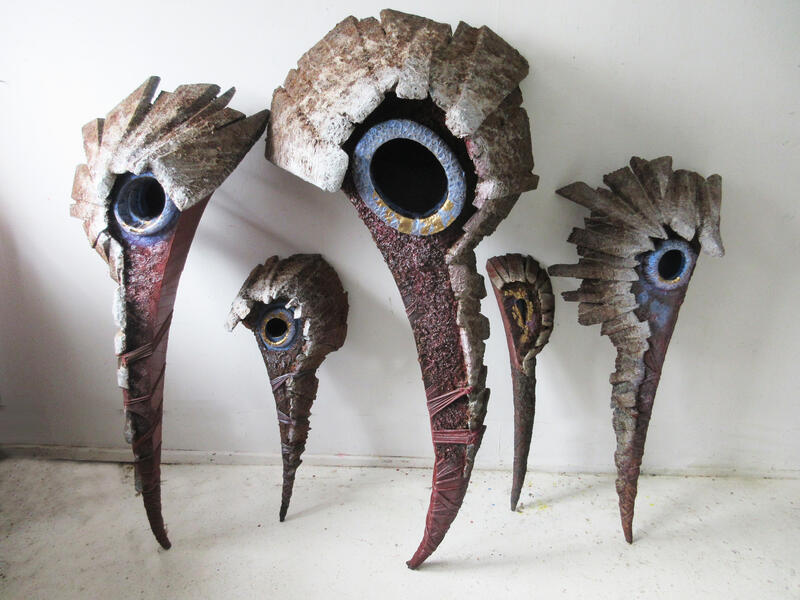 A Question of Balance: Five of Nine1991-7-2020. Wood, mixed media. Five remaining of nine original works. Adjustable positions from the wall to the floor. They also can be suspended on the wall.
A Question of Balance: Five of Nine1991-7-2020. Wood, mixed media. Five remaining of nine original works. Adjustable positions from the wall to the floor. They also can be suspended on the wall. -
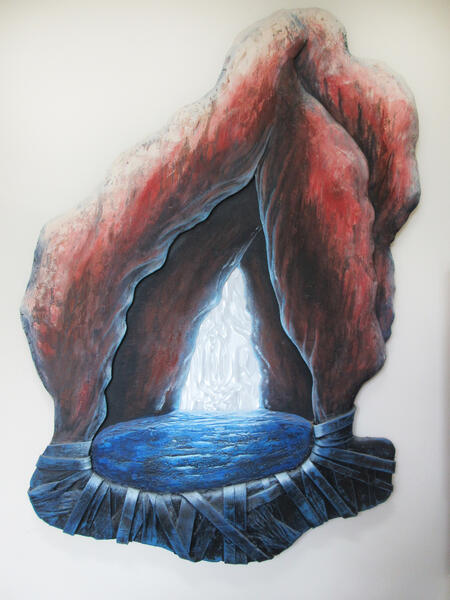 The Source1990-2020: 72" x 52" x 3"- Wood, leather belts, tar, acrylic, linticular foil.
The Source1990-2020: 72" x 52" x 3"- Wood, leather belts, tar, acrylic, linticular foil. -
Threshold1990- 50" x 90"w x 9"d Acrylic on fabric on wood, lenticular foil This piece won the first of four Maryland Artist Grants and into the Sharpe Foundation's Space Program's residency in Tribeca, NY for one year The opening is the circumference of my head.
-
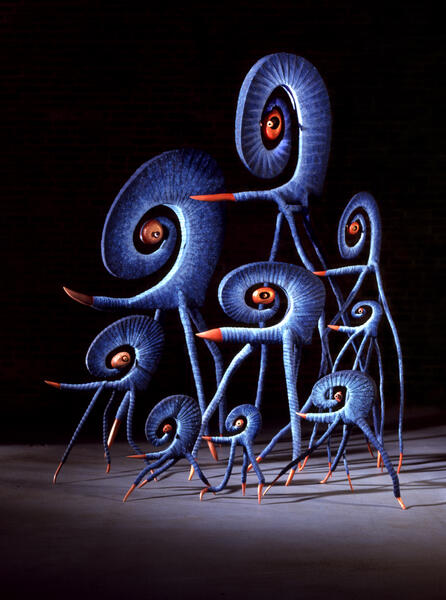 Hunting Sins1998- Nine of twelve wrapped wood multiples, variable positions. Acrylic, watch lens. 98"high All are in private collections.
Hunting Sins1998- Nine of twelve wrapped wood multiples, variable positions. Acrylic, watch lens. 98"high All are in private collections. -
The Desperation of Hope1991, New York City- Marie Walsh Sharpe Space Program Residency 93"h x 24"w x 12"d Acrylic on wood, with cotton string, sawdust and one black piano key Multiple positions
-
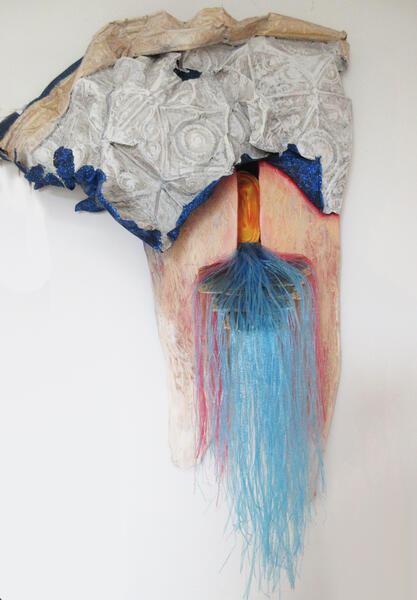 Our Father's House54" x 33" x 12"- 2018: Crushed ceiling tin on wood, acrylic, shredded Korean rope, linticular foil.
Our Father's House54" x 33" x 12"- 2018: Crushed ceiling tin on wood, acrylic, shredded Korean rope, linticular foil. -
Ascention8/2020, Made of a salvaged fragment of the bow of a 19th century sailing skiff. The wings and hand are wood.
Sculptural Forms: Part Two
-
From the Water to the Stars2016-42"h x 48"w x 10"d Two parts- Acrylic on wood, mixed media. Private collection
-
Wird, WirdWird, Wird: 2014. 8' tall- Acrylic on wood, laminated texts, 24k. Private collection
-
La Perla2003-2020 43"h x 14"w x 4"d A heat treated transluscent fabric mounted over plexiglas mirror on a wood framework. The result offers diffraction grids as the background or field.
-
Breakthrough49"h x 27"w x 2"d Acrylic on wood on plexi mirror covered in fabric. Wood covered in silk soaked in acrylic. mixed media
-
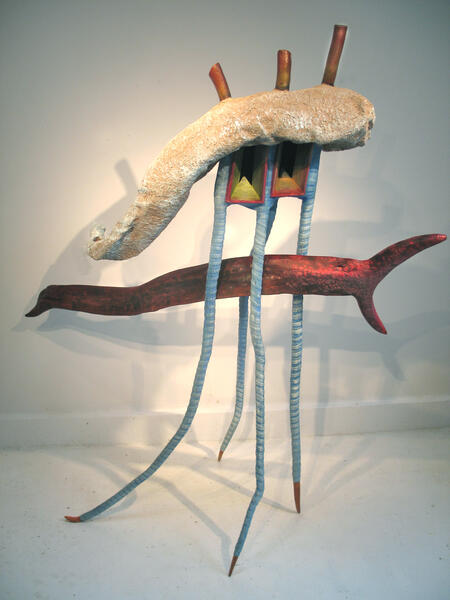 Memory's Pursuit2016- 88" x 87" x 34"- Wood, sawdust, acrylic, cotton belting, eggshell.
Memory's Pursuit2016- 88" x 87" x 34"- Wood, sawdust, acrylic, cotton belting, eggshell. -
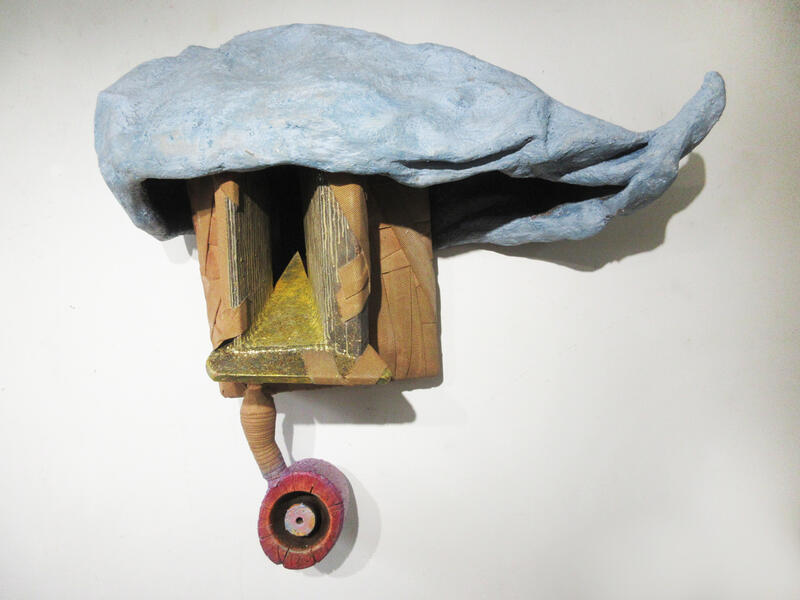 Cistern40" x 40" x 16"- 1998, Wood, sawdust, cotton belting, mixed media
Cistern40" x 40" x 16"- 1998, Wood, sawdust, cotton belting, mixed media -
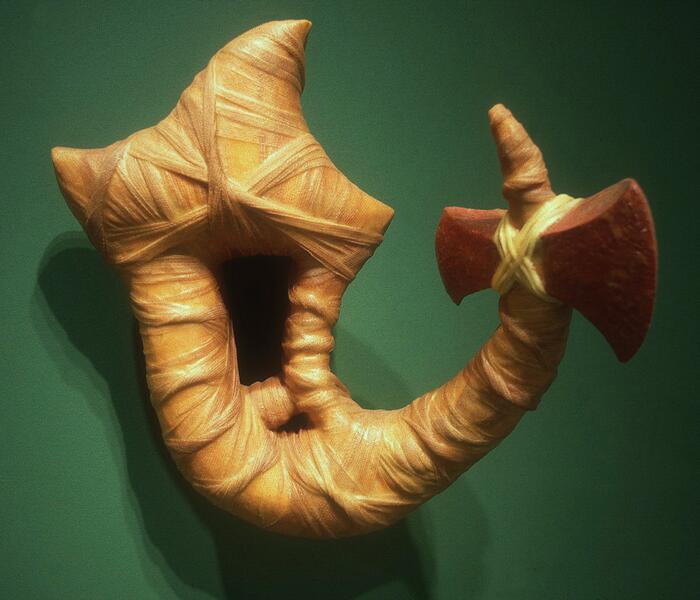 Ax Tail Slugger22"h x 25"w x 6"d Waxed Ace bandages on wood, cotton straps, velvet #66- the last in my most extensive series. Collection of the artist
Ax Tail Slugger22"h x 25"w x 6"d Waxed Ace bandages on wood, cotton straps, velvet #66- the last in my most extensive series. Collection of the artist -
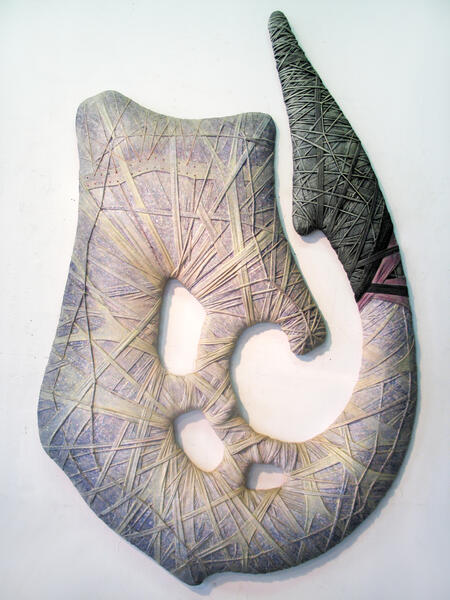 Mercy1994- 64"h, Acrylic on cotton on wood
Mercy1994- 64"h, Acrylic on cotton on wood -
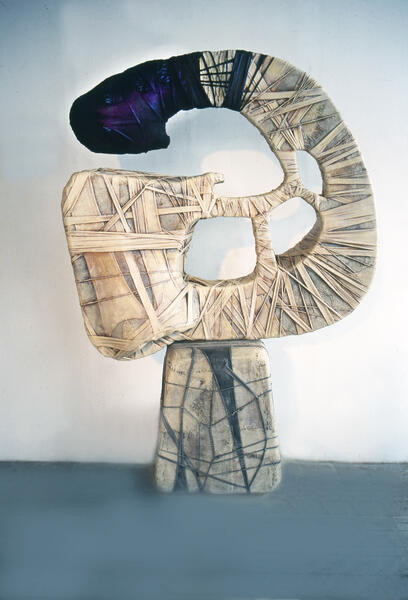 Tumpa1994- 67"h, two parts. Acrylic on cotton on wood.
Tumpa1994- 67"h, two parts. Acrylic on cotton on wood. -
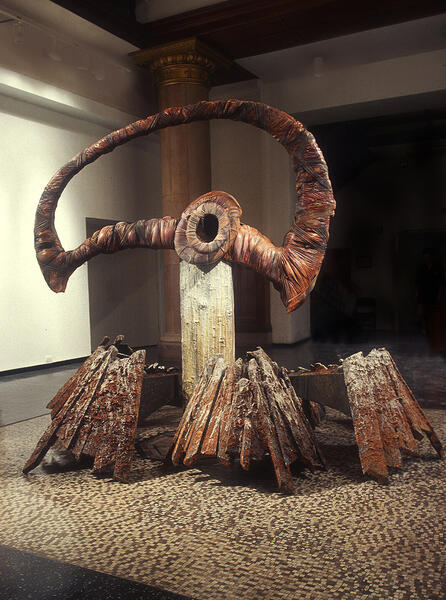 Arc Welder (With A Question of Balance)1994- 86"h- acrylic on silk on wood, with cotton cords. The base is a slab of mahogany.
Arc Welder (With A Question of Balance)1994- 86"h- acrylic on silk on wood, with cotton cords. The base is a slab of mahogany.
A Tent of Stars
Within the Tents
In 1966, when I first saw the epic, Lawrence of Arabia, it impacted and inspired my fledgling sense of identity in inexplicable ways that was to later bear fruit, from studio to performance work.
In 2013, when this series began, to my mind's eye there first appeared a nomad's tent suspended in space and covered in stars, as if in camouflage. I did not think of the movie's impact at first. However, I had first encountered nomadic tents during a 2007 visit to the Middle East. As my installation concepts are based upon creating enveloping environments, the attraction was natural.
Bedouin tents often appear as black, or dark brown or gray, looking as if they are of humble means. Yet, they often cover a profound heritage, including layers of opulent rugs and other treasures. Some families are very wealthy, yet prefer to continue living as they do. Again I encountered this during a Fulbright conference in Morocco, especially among the blue clad Touareg.
What became clear during the development of this series was that outward appearances, such as culture, race and gender, are often deceptive identifiers. For example, why do so many of us treat others the way that we do, if not by appearance, actions and gender? Yet, such externals often mask or hide the greater truth, value and meaning of our inner beings. Can we find a way to encounter each other in deeper ways?
Each tent's golden threshold symbolizes this deeper search for identity, meaning and connection. Each of us contains a mystery, be it darkness, shrouding light or as light manifested in the fruit of one's love walk and talk. I believe each person, no matter how disturbed, disenfranchised or even manifesting acts of evil, contains a core of light and truth.
Looking up to the night stars offers the open mind and heart endless awe and wonder and confronts us with our fragile lives on this tiny jewel called Earth. What do we hope for? What are we looking at? What is the condition of our own hearts in the ways we treat all others, regardless of their external signifiers?
-
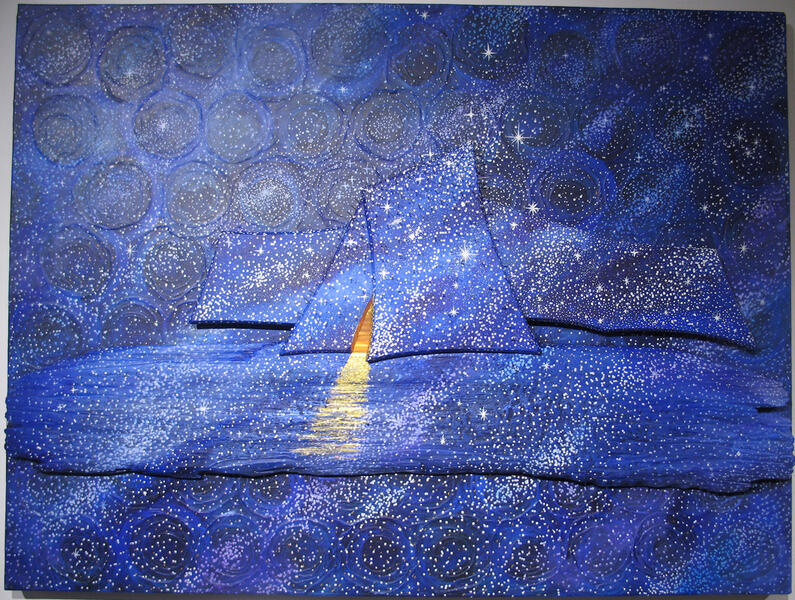 A Tent of Stars2014 36"h x 48"w x 4"d, (a private DC collection), Wood, acrylic, stainless steel nails, crystals, gold foil
A Tent of Stars2014 36"h x 48"w x 4"d, (a private DC collection), Wood, acrylic, stainless steel nails, crystals, gold foil -
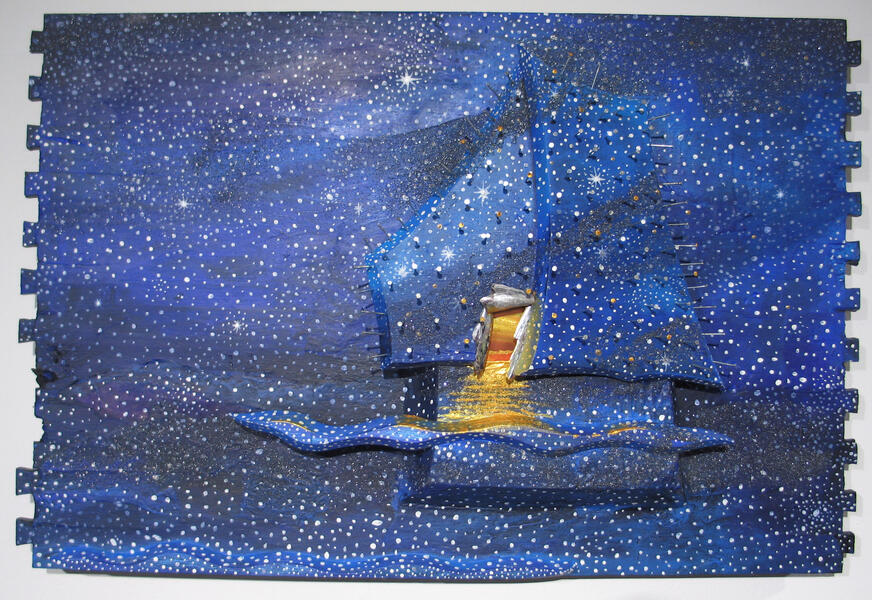 Abraham's Promise12/2013 15"h x 26"w x 5"d Wood, stainless brads, crystals, carborundum,mother of pearl, acrylic #1 in the series. (A private collection)
Abraham's Promise12/2013 15"h x 26"w x 5"d Wood, stainless brads, crystals, carborundum,mother of pearl, acrylic #1 in the series. (A private collection) -
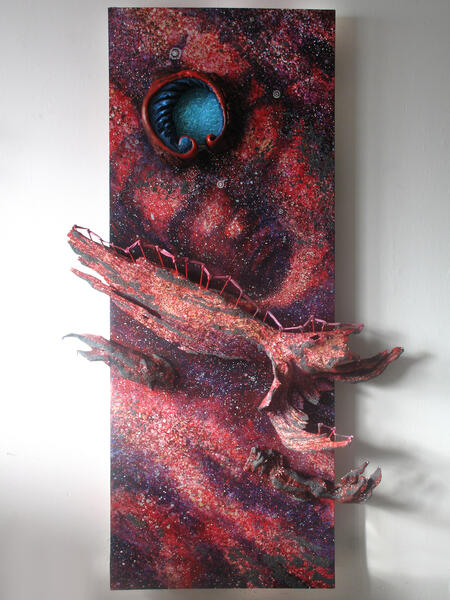 The Fall2014 79"h x 43"w x 9"d Third in the set, driftwood, body putty, screws, stainless brads, crystals on acrylic, optical plastic.
The Fall2014 79"h x 43"w x 9"d Third in the set, driftwood, body putty, screws, stainless brads, crystals on acrylic, optical plastic. -
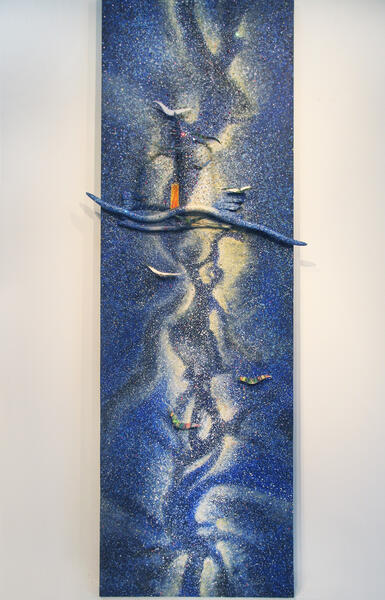 Dalet (The Door)2014 80"h x 28"w x 4"d First of three. Wood door, wood, stainless brads, optical plastic, acrylic, crystals
Dalet (The Door)2014 80"h x 28"w x 4"d First of three. Wood door, wood, stainless brads, optical plastic, acrylic, crystals -
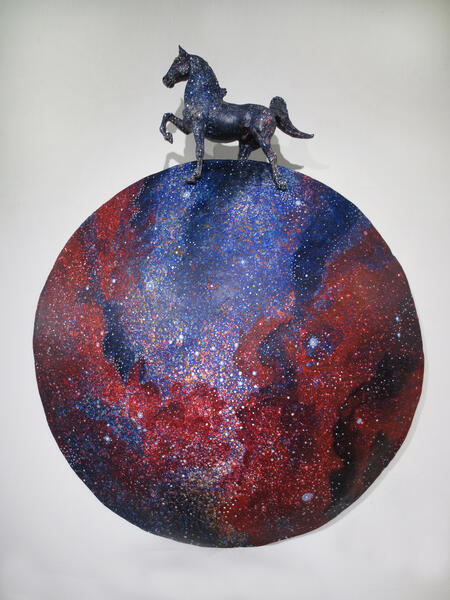 Deep unto Deep2014 35"h x 28"w x 10"d One of three 'Star Shields', each topped by a differing horse. Each convex shield has a leather encased, rope hand grip grometted to the concave side, which hangs on a wood wall mount and can be easily lifted and carried. Fiberglass, acrylic, crystals
Deep unto Deep2014 35"h x 28"w x 10"d One of three 'Star Shields', each topped by a differing horse. Each convex shield has a leather encased, rope hand grip grometted to the concave side, which hangs on a wood wall mount and can be easily lifted and carried. Fiberglass, acrylic, crystals -
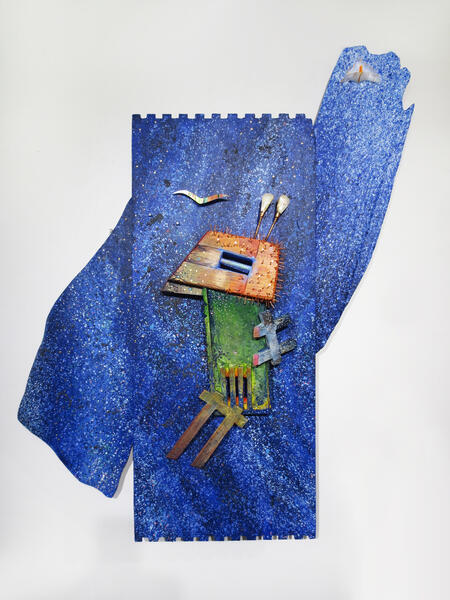 Released2014 40"h x 32"w x 3"d Wood, acrylic, Mother of Pearl nut pickers, sterling, steel, optical plastics, crystals a self portrait
Released2014 40"h x 32"w x 3"d Wood, acrylic, Mother of Pearl nut pickers, sterling, steel, optical plastics, crystals a self portrait -
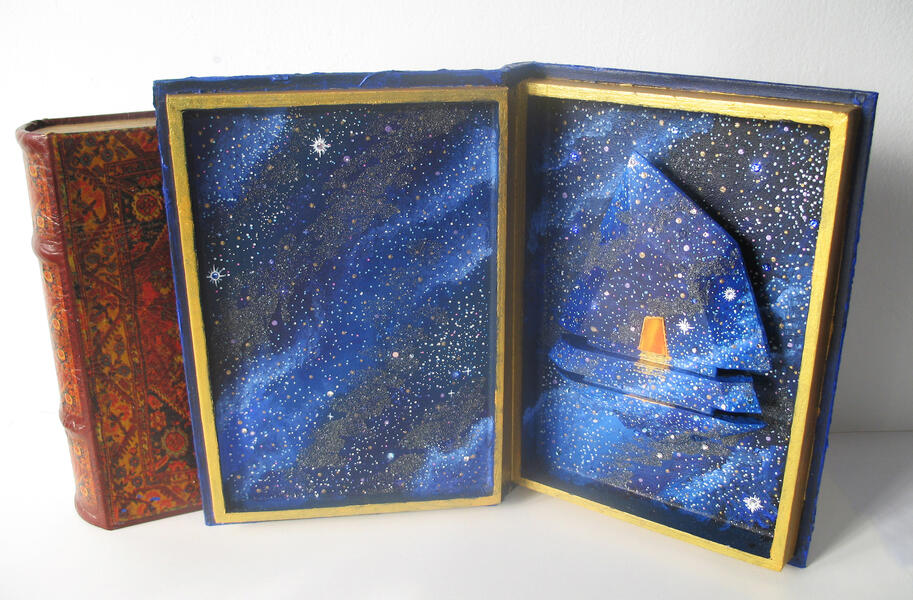 A Book of Stars (Set of 4 completed)2014 12"h x 8.5"h x 2"d Private collection One of three books. Wood, fabric, acrylic, crystals, carborundum, optical plastic. (All finished works are in private collections) New books can be ordered.
A Book of Stars (Set of 4 completed)2014 12"h x 8.5"h x 2"d Private collection One of three books. Wood, fabric, acrylic, crystals, carborundum, optical plastic. (All finished works are in private collections) New books can be ordered. -
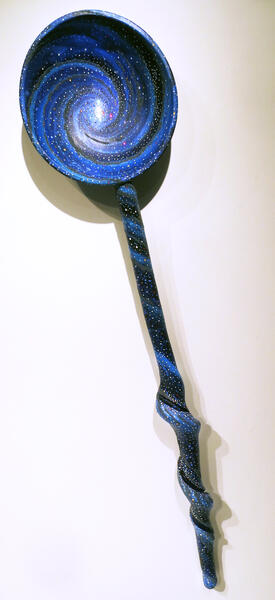 Measuring Hope1/2015 53"h x 13"w x 3"d Wood, acrylic, crystals
Measuring Hope1/2015 53"h x 13"w x 3"d Wood, acrylic, crystals -
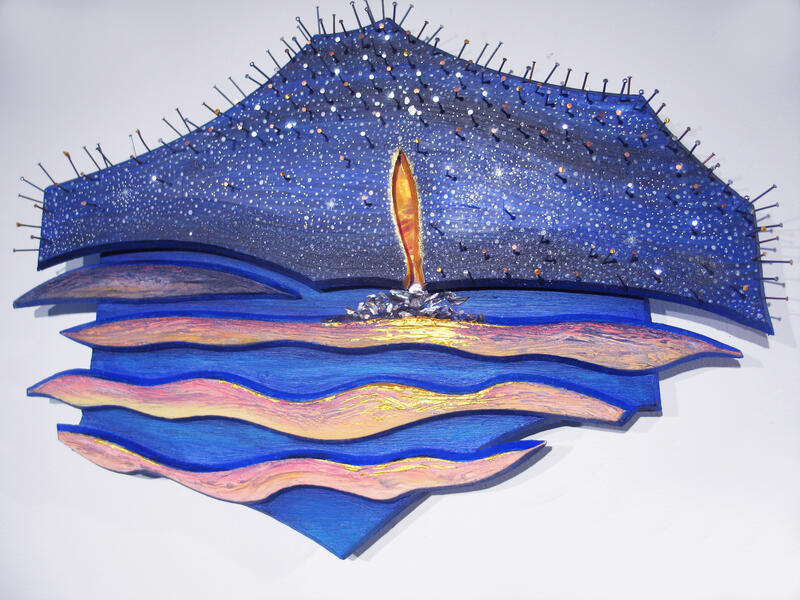 Eye of the Needle2014 15"h x 22"w x 3"d Acrylic on wood, stainless brads, crushed mother of pearl, crystals. (A private collection)
Eye of the Needle2014 15"h x 22"w x 3"d Acrylic on wood, stainless brads, crushed mother of pearl, crystals. (A private collection)
Ship Installations
At nine months old, I learned to walk aboard an ocean liner crossing the Pacific Ocean. Since then I've been aboard supertankers, WWII military landing crafts, yachts, trimarans, speedboats, dug out canoes and outriggers. So, it was only natural that my work often cycles through the ship as an metaphor of life's journey, from the womb to the cradle to the coffin.
In 2000, I began a new series of large-scale, ship-shaped installations built around on-site trees as the sails. Each was intended to serve their local communities as a gathering place or informal social practice. They also served as crucibles for experimental photography, video and performance.
Their interiors welcomed visitors as participants and dreamers, which many claimed as their own. For example, a small girl in Annapolis learned from her parents that she was the captain of her own ship.
-
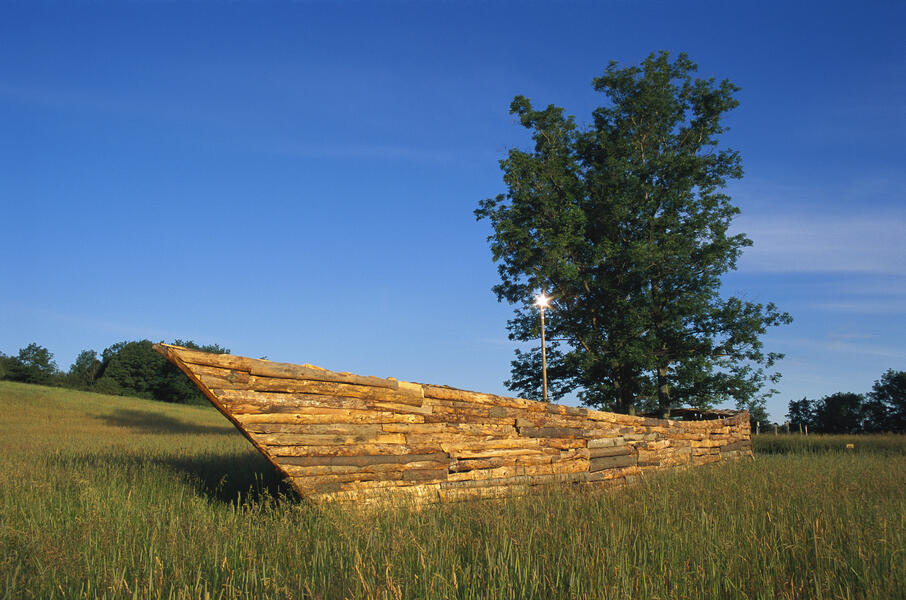 The Scent of Light2000-2006, Stone Quarry Hill Art Park, Casenovia, New York. 16'h at the light pole. 81 'long and 24 feet wide. Eleven tons of wood set on 24 cement footers. Constructed around four hickory trees as the sails. The interior had a viewing deck, stairs and multiple seating options. An antique door with watered glass opened to the interior, which walls contained an array of quotes from world literature, both from the artist and visitors. The light pole was held in place by five tons of stacked slate and is topped by a three foot tall egg shape covered in reflective elements. Named after a poem by the Sufi mystic Hafez.
The Scent of Light2000-2006, Stone Quarry Hill Art Park, Casenovia, New York. 16'h at the light pole. 81 'long and 24 feet wide. Eleven tons of wood set on 24 cement footers. Constructed around four hickory trees as the sails. The interior had a viewing deck, stairs and multiple seating options. An antique door with watered glass opened to the interior, which walls contained an array of quotes from world literature, both from the artist and visitors. The light pole was held in place by five tons of stacked slate and is topped by a three foot tall egg shape covered in reflective elements. Named after a poem by the Sufi mystic Hafez. -
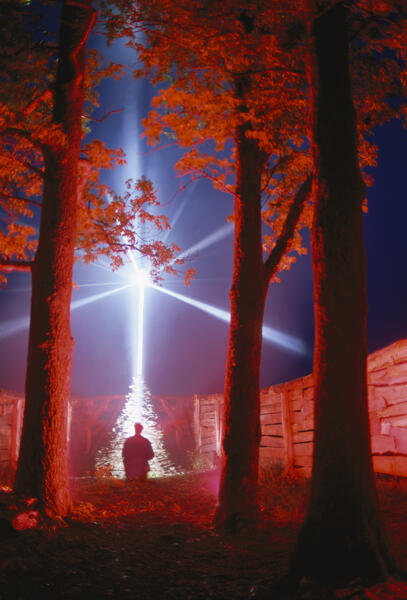 CantusThis photo was shot as a 35mm time exposure inside The Scent of Light, which was located at Stone Quarry Hill Art Park in upper New York. (2000-2006) The red color comes from car flares set inside frying pans set behind the trees. Alone, I pushed the camera trigger, ran into the exposure and then hand held a 1 million watt flash light up to the reflective sculpture on top of the pole.The 'glory' effect resulted from clouds blowing in that night. Edition of 3 artists proofs 66"h x 44"w Each print is formatted uniquely. The first proof was shown in the Ace Gallery, NY and in London at Virgin headquarters and is now in the collection of the Everson Museum, Syracuse, NY.
CantusThis photo was shot as a 35mm time exposure inside The Scent of Light, which was located at Stone Quarry Hill Art Park in upper New York. (2000-2006) The red color comes from car flares set inside frying pans set behind the trees. Alone, I pushed the camera trigger, ran into the exposure and then hand held a 1 million watt flash light up to the reflective sculpture on top of the pole.The 'glory' effect resulted from clouds blowing in that night. Edition of 3 artists proofs 66"h x 44"w Each print is formatted uniquely. The first proof was shown in the Ace Gallery, NY and in London at Virgin headquarters and is now in the collection of the Everson Museum, Syracuse, NY. -
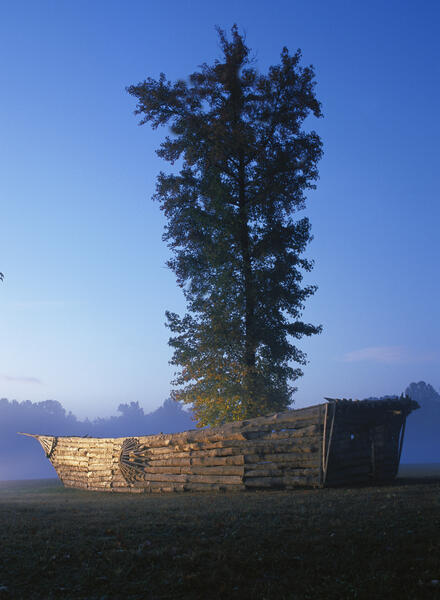 Hunting Light2001/06 The second ship in the series and perhaps my favorite project ever. Formerly located at Quiet Waters Park, Annapolis, MD. 72ft l x 22ftw x 12ft h. 14 tons of wood, 22 cement footers. Four interior chambers with seating, world literature quotes, sculpture. It served as a basis for performance, photography and video. More important, lots of fun events happened in it with a great many children of all ages. The most powerful was when 3 young boys left a hand made American flag on 9/11. I came that afternoon, in pouring rain. The flag is still with me.
Hunting Light2001/06 The second ship in the series and perhaps my favorite project ever. Formerly located at Quiet Waters Park, Annapolis, MD. 72ft l x 22ftw x 12ft h. 14 tons of wood, 22 cement footers. Four interior chambers with seating, world literature quotes, sculpture. It served as a basis for performance, photography and video. More important, lots of fun events happened in it with a great many children of all ages. The most powerful was when 3 young boys left a hand made American flag on 9/11. I came that afternoon, in pouring rain. The flag is still with me. -
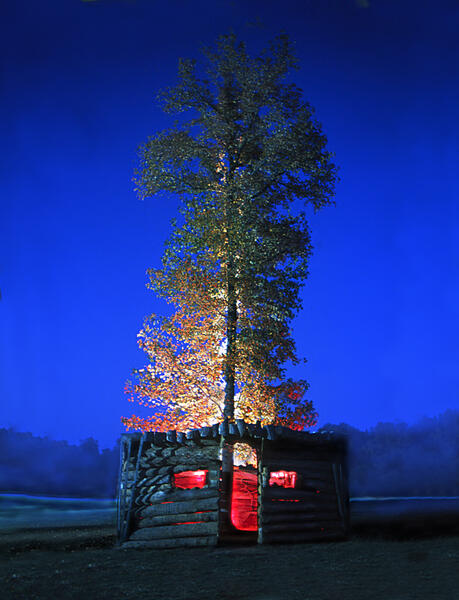 untitledCentral image for a planned tryptych. White light is from my auto headlights. Red is a car flare in a frying pan.
untitledCentral image for a planned tryptych. White light is from my auto headlights. Red is a car flare in a frying pan. -
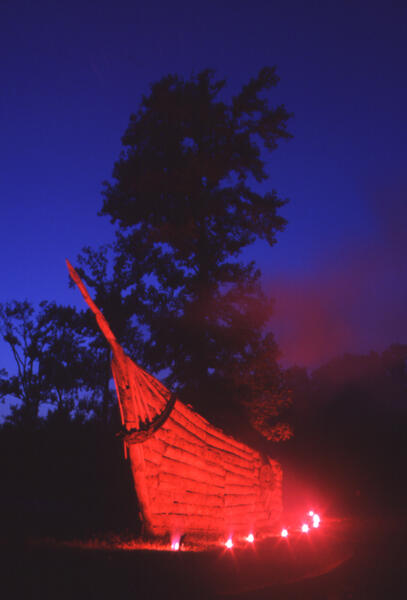 Hunting LightNight performance.
Hunting LightNight performance. -
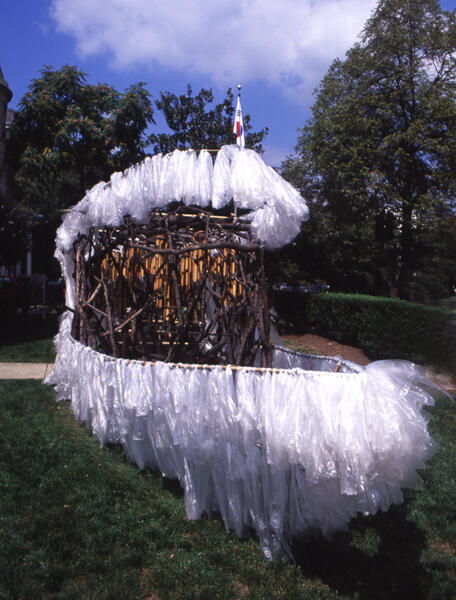 Earthsong11/2002-The front lawn of the Korean Cultural Service of the Korean Embassy in Washington, D.C. Part of a proposal for a senior Fulbright to Seoul (2003-2004) The ship is split by a sidewalk (North and South) and is made of bamboo, wood, plastic and 38 bamboo wind chimes representing the 38th parallel by which Korea remains divided. An interior exhibition showed related sculpture and photography.
Earthsong11/2002-The front lawn of the Korean Cultural Service of the Korean Embassy in Washington, D.C. Part of a proposal for a senior Fulbright to Seoul (2003-2004) The ship is split by a sidewalk (North and South) and is made of bamboo, wood, plastic and 38 bamboo wind chimes representing the 38th parallel by which Korea remains divided. An interior exhibition showed related sculpture and photography. -
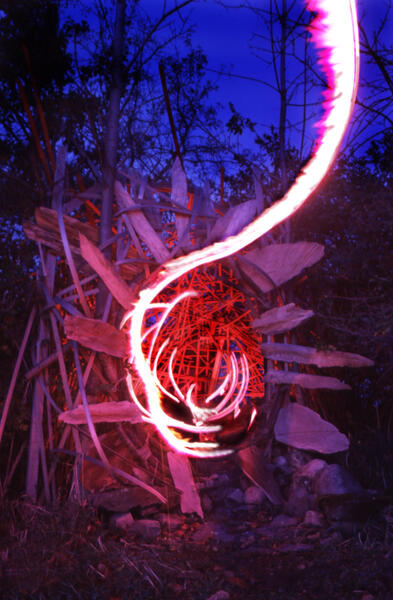 Grotto (The Scent of Light)This is the second part of the Scent of Light installation, as a symbolic safe harbor for the ship. It is located in a thicket about 50 yards directly off the bow site of the ship. A path was cut through the tall grass that ran alongside the ship to the Grotto. inside, 5 tons of large stones formed a circle around a recessed circle of black slag sand. The exposure was at twilight- a 35mm one minute exposure using a car flare. My moving body blocked out segments of the flair's trail.
Grotto (The Scent of Light)This is the second part of the Scent of Light installation, as a symbolic safe harbor for the ship. It is located in a thicket about 50 yards directly off the bow site of the ship. A path was cut through the tall grass that ran alongside the ship to the Grotto. inside, 5 tons of large stones formed a circle around a recessed circle of black slag sand. The exposure was at twilight- a 35mm one minute exposure using a car flare. My moving body blocked out segments of the flair's trail. -
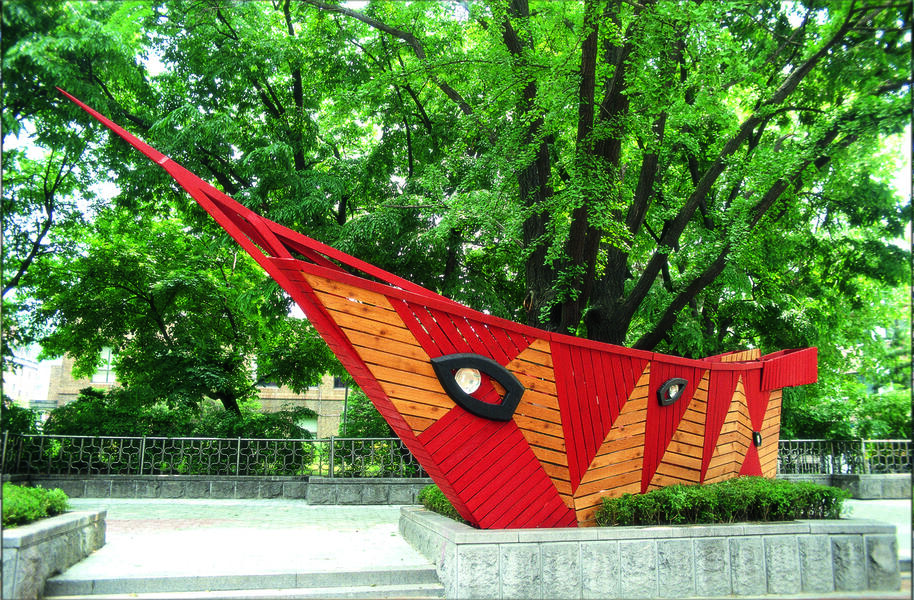 Hand in Hand2004- 2008 Constructed in front of the Ministry of Arts and Culture in Seoul, Korea. Specially treated cedar, stainless steel rice bowls, interior has two one million watt street lambs that come on at twlight-shedding light upon the sidewalk and up into the gingko-(a tree sacred to Koreans) 1200 x 330 x 336 cm The bow pointed towards Pyeongyang, the capital of North Korea. The hull was designed as two halves not yet aligned. A catalogue and DVD are available. Project grant- $7500, from Sung Kyun Kwan University.
Hand in Hand2004- 2008 Constructed in front of the Ministry of Arts and Culture in Seoul, Korea. Specially treated cedar, stainless steel rice bowls, interior has two one million watt street lambs that come on at twlight-shedding light upon the sidewalk and up into the gingko-(a tree sacred to Koreans) 1200 x 330 x 336 cm The bow pointed towards Pyeongyang, the capital of North Korea. The hull was designed as two halves not yet aligned. A catalogue and DVD are available. Project grant- $7500, from Sung Kyun Kwan University. -
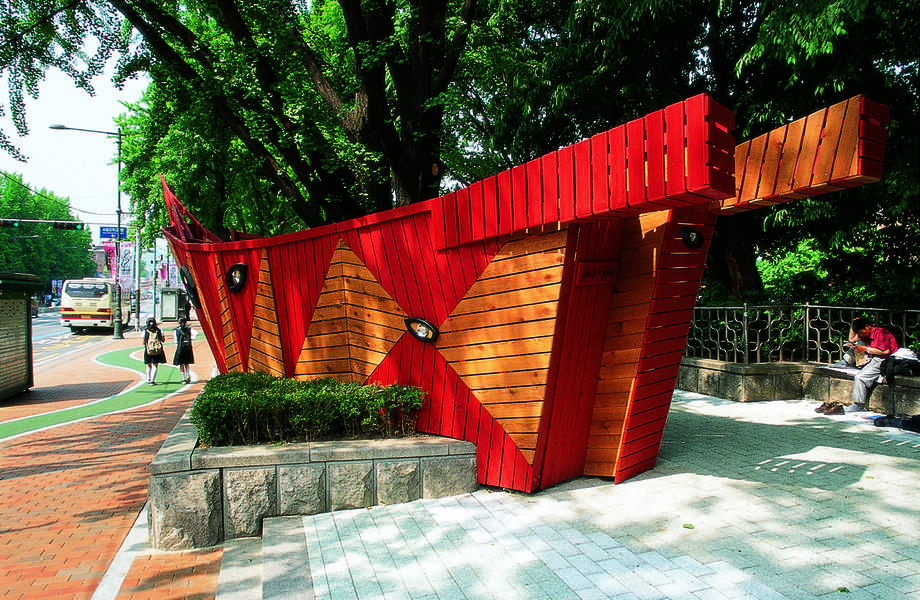 Hand in HandThe stern showing the split hull design and entry door. Due to high volume and safety concerns on University Blvd, the interior is closed to the public.
Hand in HandThe stern showing the split hull design and entry door. Due to high volume and safety concerns on University Blvd, the interior is closed to the public. -
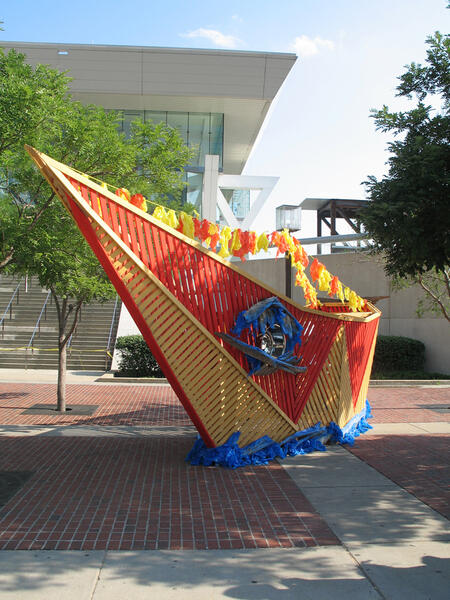 Dancing LightLocated on the corner of the Baltimore Convention Center (06/2006-07) as part of Artscape- Milled wood, driftwood, stainless steel bowls, plastic, epoxy paint, cement footers. 30'lx12'wx9'd- $1500 stipend. Based upon the Korean prototype, this installation had more widely spaced slats and is the first not built around a tree (or of natural tree branches), but rather between 4 small trees (the cardinal directions) around a light post and two additional street lamps that came on in the evening. These illuminated the world literature quotes written on the inside. Due to high traffic and safety concerns, the interior was closed to the public. No DVD available. Currently i plan to reuse the reclaimed triangular panels in a more abstracted installation in my garden.
Dancing LightLocated on the corner of the Baltimore Convention Center (06/2006-07) as part of Artscape- Milled wood, driftwood, stainless steel bowls, plastic, epoxy paint, cement footers. 30'lx12'wx9'd- $1500 stipend. Based upon the Korean prototype, this installation had more widely spaced slats and is the first not built around a tree (or of natural tree branches), but rather between 4 small trees (the cardinal directions) around a light post and two additional street lamps that came on in the evening. These illuminated the world literature quotes written on the inside. Due to high traffic and safety concerns, the interior was closed to the public. No DVD available. Currently i plan to reuse the reclaimed triangular panels in a more abstracted installation in my garden.
Ocean @ the Creative Alliance-
Both the exterior and interior surfaces incorporated an eclectic range of diverse materials and found objects. Eight performance costumes hung on stands outside the entrances, which were available for the public to don while exploring the rooms.Inside, five videos of prior performances were shown in various locations. Slide projections of my travels were also projected onto various surfaces. Oscillating fans were located in each space and transition point and softly blew hanging materials back and forth. An inverted antique sailing skiff served as the roof of the Drowning Room, while various rooms included sofas and chairs buried under layers of materials, among other seating options.
The green, silk-lined and padded Sex Cage proved the most memorable with certain visitors falling asleep... until after closing, which then set off the alarm and brought the police.
-
OceanThe main entrance showing a few of the wearable costumes. The yellow is on its stand. The blue in on the floor.
-
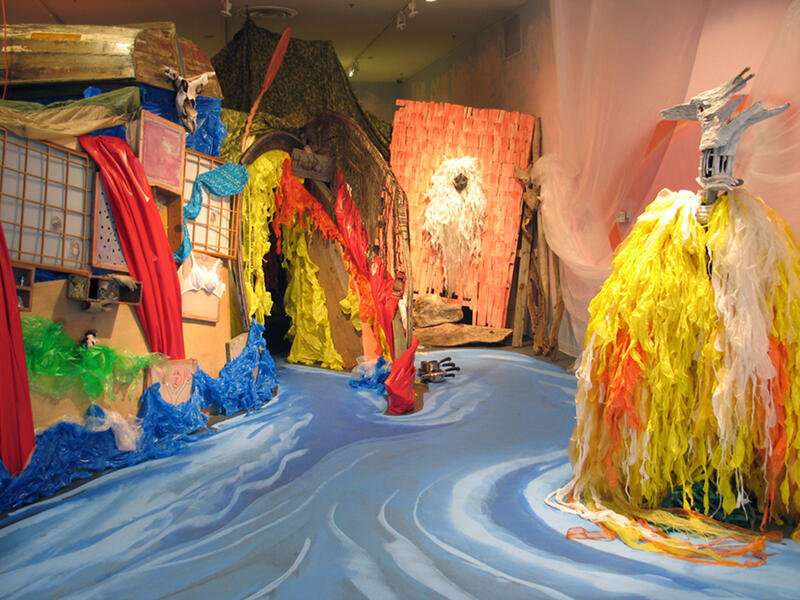 Ocean- the main entranceLocated on the port side, this was also the main performance area. The seven elements, or costumes, as in the case of this yellow one, could be taken off their armatures and worn by the general public. This proved numerous opportunities for people to dance for the first time in and out of a work of art. Parents often followed their children. Every visit was a constant surprise of people and engaging conversations. I spent most weekends on site.
Ocean- the main entranceLocated on the port side, this was also the main performance area. The seven elements, or costumes, as in the case of this yellow one, could be taken off their armatures and worn by the general public. This proved numerous opportunities for people to dance for the first time in and out of a work of art. Parents often followed their children. Every visit was a constant surprise of people and engaging conversations. I spent most weekends on site. -
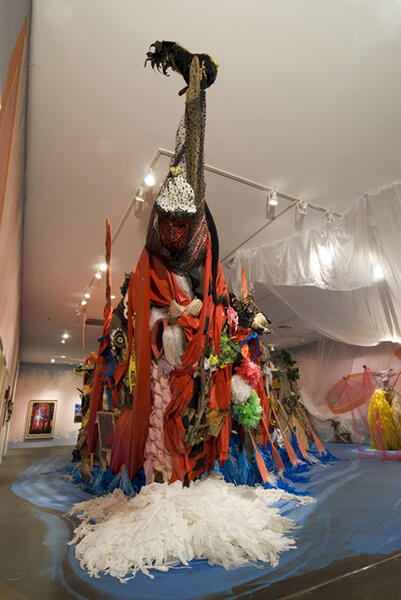 Ocean's bowThis shows the installation as first viewed by visitors. The construction was set on a diagonal across the 2000 sq ft gallery, which was mostly filled by the 8 interactive rooms. The hull surface was covered by a diverse array of materials as a critique of our run-away consumer culture. On top of the bow sat a stuffed rooster wearing a large fake blue gem (ala the Titanic) Quotes from world literature were written into sections of this exterior surface and inside each room.
Ocean's bowThis shows the installation as first viewed by visitors. The construction was set on a diagonal across the 2000 sq ft gallery, which was mostly filled by the 8 interactive rooms. The hull surface was covered by a diverse array of materials as a critique of our run-away consumer culture. On top of the bow sat a stuffed rooster wearing a large fake blue gem (ala the Titanic) Quotes from world literature were written into sections of this exterior surface and inside each room. -
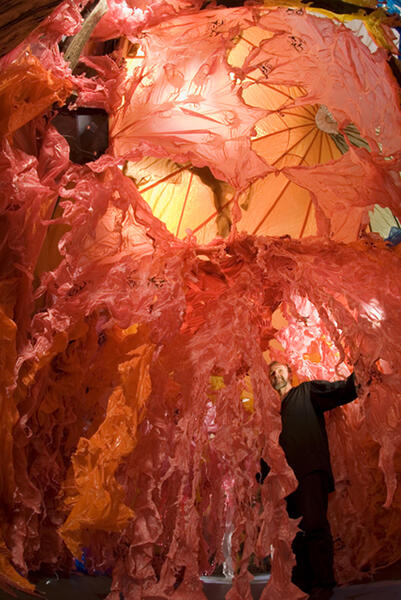 The Gullet of the WhaleThis was the wind blown passage that led to the Belly of the Whale video room. The plastics are all bio-hazard bags. Their warning signs, although often stretched, would on occasion appear right at visitor eye level.
The Gullet of the WhaleThis was the wind blown passage that led to the Belly of the Whale video room. The plastics are all bio-hazard bags. Their warning signs, although often stretched, would on occasion appear right at visitor eye level. -
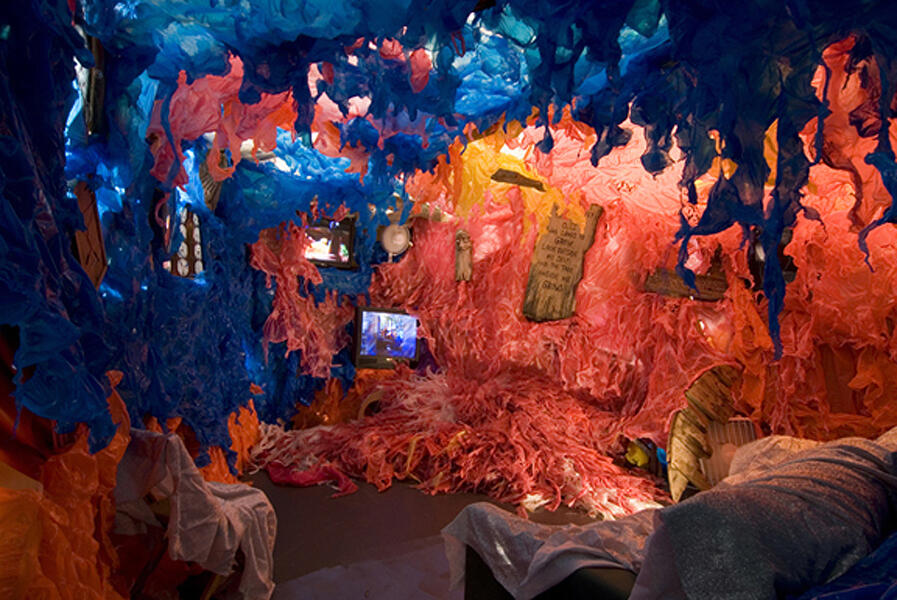 Belly of the WhaleThis contained two videos, X-ray windows, texts, a couch, seating and the entrance to the Drowning Room. Half way through the month, I opened a third door to the left of this view, allowing a greater flow for the increasing crowds.
Belly of the WhaleThis contained two videos, X-ray windows, texts, a couch, seating and the entrance to the Drowning Room. Half way through the month, I opened a third door to the left of this view, allowing a greater flow for the increasing crowds. -
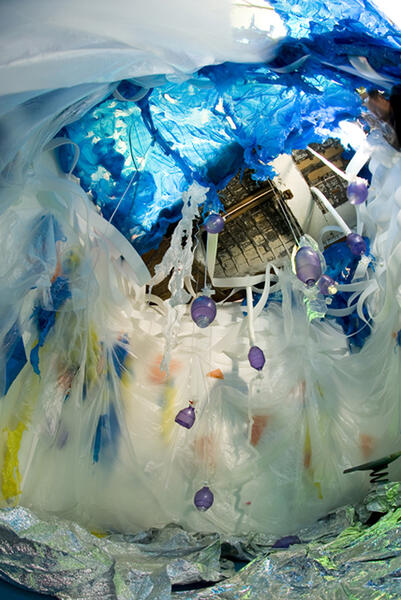 The Drowning RoomThe most controversial room in the ship. The view is looking from the floor to the ceiling, which was capped by an inverted 20 ft antique sailing skiff- from which hung a series of oxygen breathing apparatus. The backlit blue plastic created a strong blue light inside the space. Contrasting that effect, a special light inside the boat overhead created an underwater effect reflected upon the silver Mylar floor, and back upon the walls. This room frightened more people than the rest of the ship combined.
The Drowning RoomThe most controversial room in the ship. The view is looking from the floor to the ceiling, which was capped by an inverted 20 ft antique sailing skiff- from which hung a series of oxygen breathing apparatus. The backlit blue plastic created a strong blue light inside the space. Contrasting that effect, a special light inside the boat overhead created an underwater effect reflected upon the silver Mylar floor, and back upon the walls. This room frightened more people than the rest of the ship combined. -
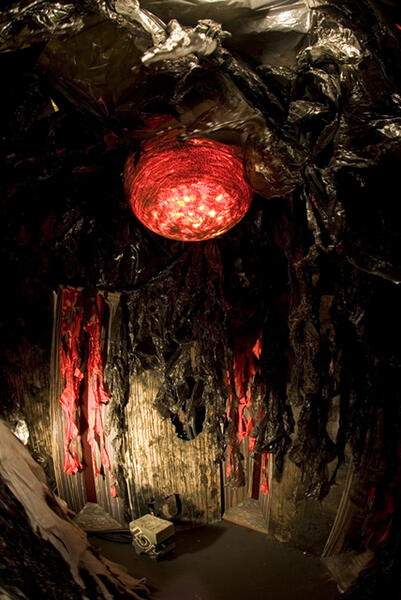 The Apocalypse RoomThe most hidden and smallest room containing several burned doors, a partially hidden illuminated resin skull and an overhead 32"diameter illuminated fiberglass globe questioning the future of our planet. In essence, this was the underlying critique of the installation. On it's bottom was a single phrase- 'Our future?' Below it was a small stool you could sit upon. on one side it said- 'Think' and on the other side- 'Act'
The Apocalypse RoomThe most hidden and smallest room containing several burned doors, a partially hidden illuminated resin skull and an overhead 32"diameter illuminated fiberglass globe questioning the future of our planet. In essence, this was the underlying critique of the installation. On it's bottom was a single phrase- 'Our future?' Below it was a small stool you could sit upon. on one side it said- 'Think' and on the other side- 'Act' -
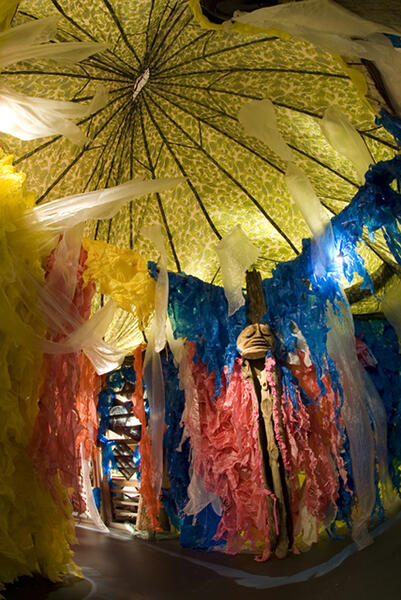 CryThe central interior hall that connected the three main branches of the ship. This centered upon this wood figure recycled from the Forest House project. Three hidden oscillating fans constantly blew about the suspended plastic tendrils and rustled the torn plastics, giving the interior a constant rustling sound, almost like a forest.
CryThe central interior hall that connected the three main branches of the ship. This centered upon this wood figure recycled from the Forest House project. Three hidden oscillating fans constantly blew about the suspended plastic tendrils and rustled the torn plastics, giving the interior a constant rustling sound, almost like a forest. -
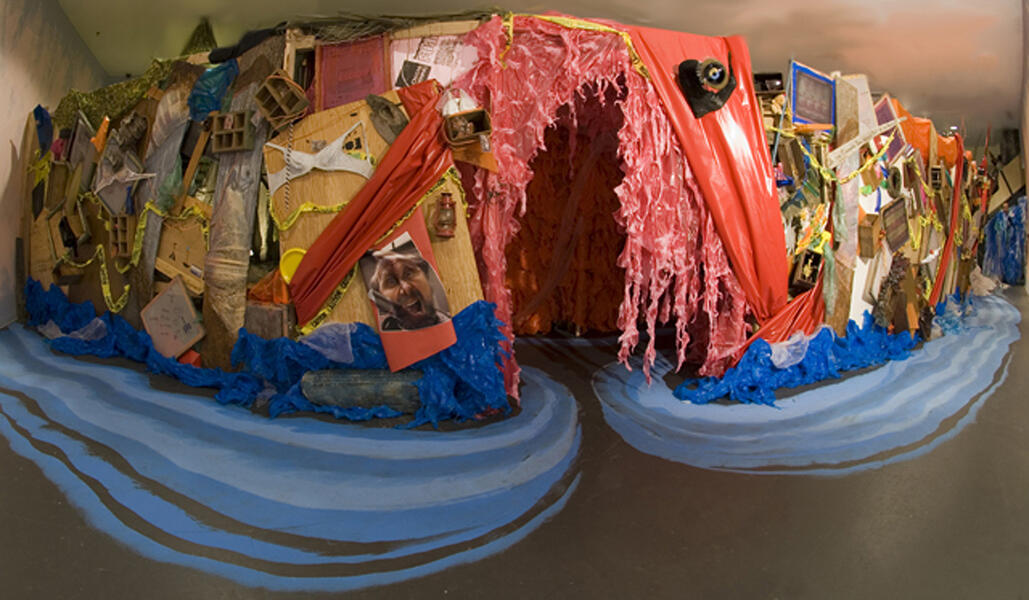 Ocean- the starboard doorThis led directly into the windblown 'Gullet of the Whale'. Assorted found objects mixed with art works.
Ocean- the starboard doorThis led directly into the windblown 'Gullet of the Whale'. Assorted found objects mixed with art works. -
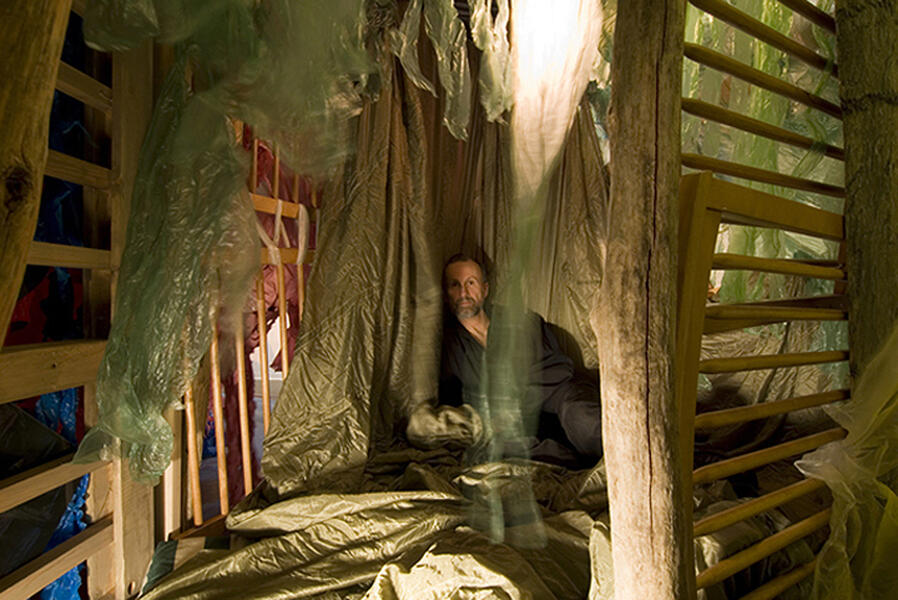 Ocean: Sex CageAn elevated and padded platform enclosed in bars and wrapped in green parachute silk.
Ocean: Sex CageAn elevated and padded platform enclosed in bars and wrapped in green parachute silk.
The Sky Below, Earth Above: Forest House
So, I determined to make a work that would critique this- by using some of this garbage to create a challenging context. What resulted was a surprise in many ways, both positive and unfortunately, negative.
First of all, it's remote location was originally rarely frequented outside of joggers and hikers, even though the site was among the tallest stands of original trees in the park, on a hill overlooking a sheltered cove. As the installation drew near to completion, it began to draw people in increasing numbers. Each time I returned, I found more and more repeat visitors. People brought picnics. Children played. Music happened. The word spread. I was most amazed when I was introduced to a European couple who flew in because their friend said it was worth the trip! An informal festival like air took over. That autumn was one of wonders upon wonders as I almost lived in it, refining details and happily talking with people who often helped with difficult parts. Many spoke that it brought a profound sense of peace and wonder.
However, it proved to be the most controversial project of my career. Within three months, it was condemned by two small groups of wealthy Annapolis people. I met with one of them on site- a most amazing experience of being absolutely hated as if I was the devil. He refused my handshake. Nothing I said was heard. His hatred was so far off the charts as to not touch me. Rather than being offended, I was astonished that this well meaning work of art could provoke such a completely different response from the others I had been experiencing.
They saw it as either an illegal religious Christian chapel on government land- or as a Satanist sacrifice center. It rapidly became the center of a public storm that resulted in coverage by the Associated Press and an article in Sculpture Magazine. Despite hundreds of local people supporting it and a professional offer to take the case to court (for free), those wealthy people bypassed the director of Maryland's state park system (who had visited it and delightfully approved the project)... and managed to get it torn down prematurely- condemned by the State as a building without a building permit!
A DVD is available.
-
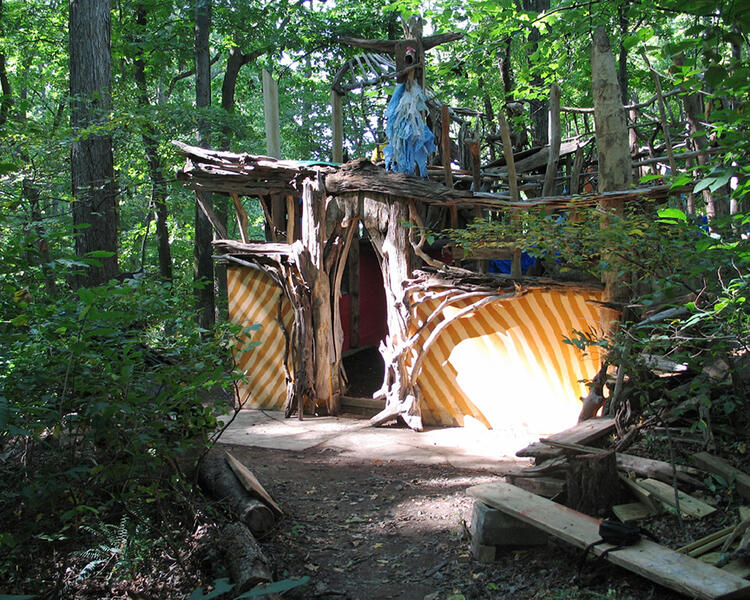 Forest House- the main entrance9am Sept 23, 2006- a brief period of time in which the morning sun would illuminate the outer entrance wall.
Forest House- the main entrance9am Sept 23, 2006- a brief period of time in which the morning sun would illuminate the outer entrance wall. -
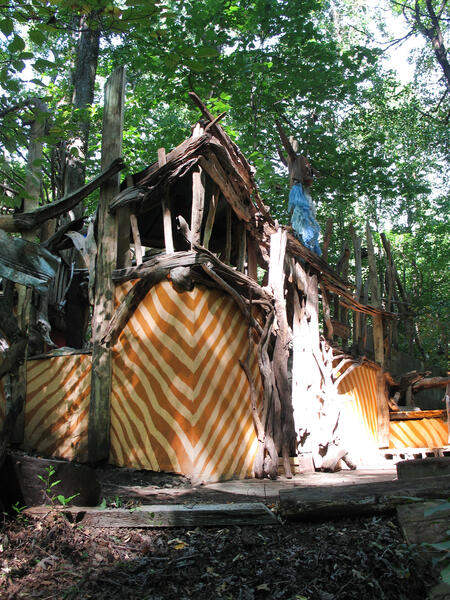 Forest HouseDuring September into October, in the morning light the entrance would be highlighted around 8 to 9am
Forest HouseDuring September into October, in the morning light the entrance would be highlighted around 8 to 9am -
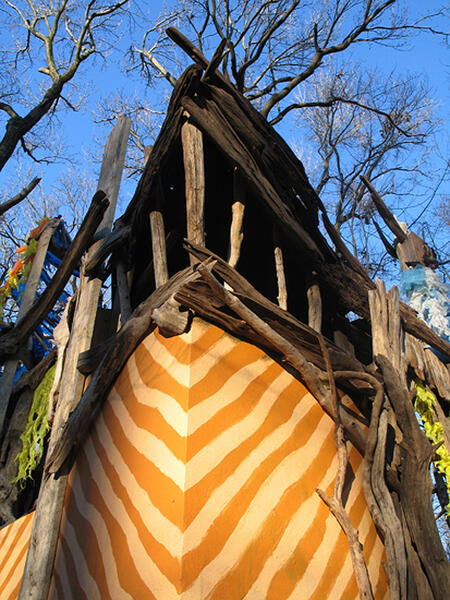 Forest House cornerShot in winter, giving the appearance of a ship's bow and a cage.
Forest House cornerShot in winter, giving the appearance of a ship's bow and a cage. -
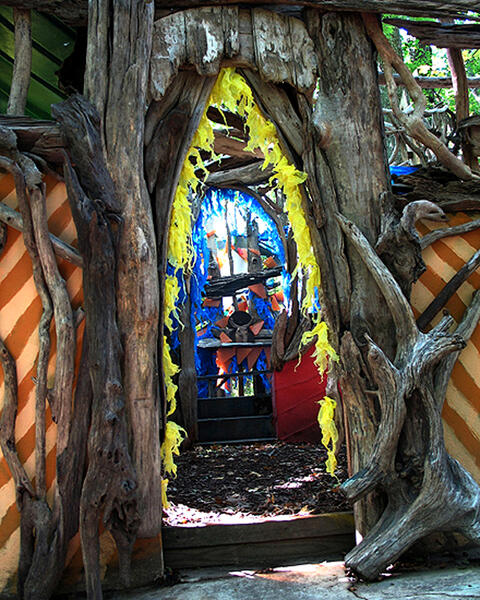 The entranceLooking through the first room, up the two steps to the main room and the altar.
The entranceLooking through the first room, up the two steps to the main room and the altar. -
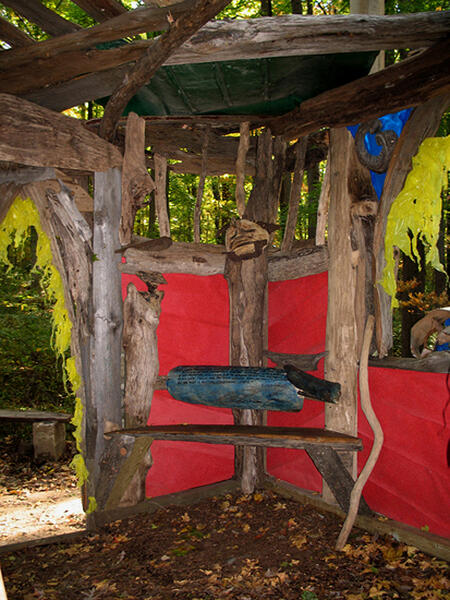 Inside the entranceThis shows one of the benches that was mistaken as Christ crucified. Titled 'Cry'
Inside the entranceThis shows one of the benches that was mistaken as Christ crucified. Titled 'Cry' -
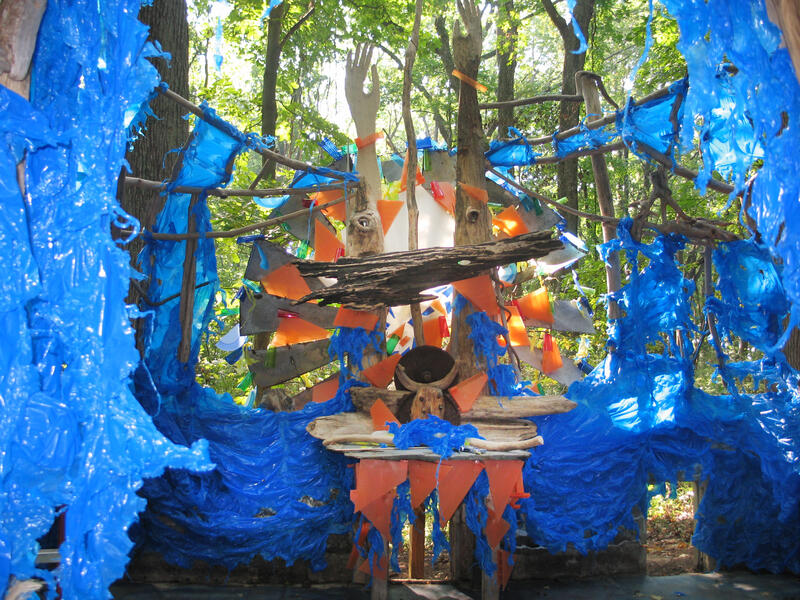 The main roomThe most controversial part of the installation was the table. Made from an old slate slab from a sink excavated while cleaning up the site. It was seen as an altar. The water wheel that supported the wood arms was from the original farm and also excavated. The orange plastic was a bonanza find- they had unknown function, but I cut them into fragments and wired them into place.
The main roomThe most controversial part of the installation was the table. Made from an old slate slab from a sink excavated while cleaning up the site. It was seen as an altar. The water wheel that supported the wood arms was from the original farm and also excavated. The orange plastic was a bonanza find- they had unknown function, but I cut them into fragments and wired them into place. -
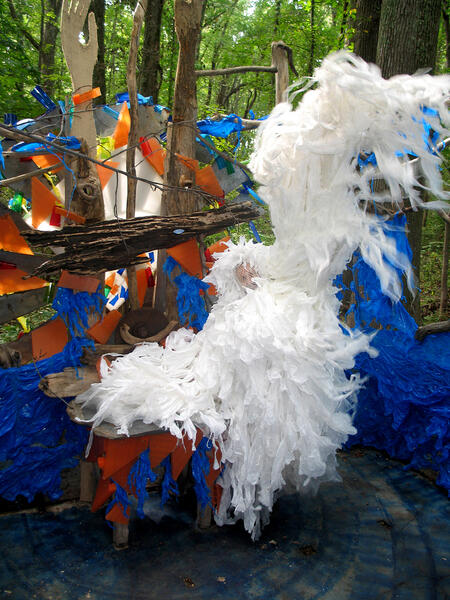 Forest House performanceA simple 15 min performance to drums.
Forest House performanceA simple 15 min performance to drums. -
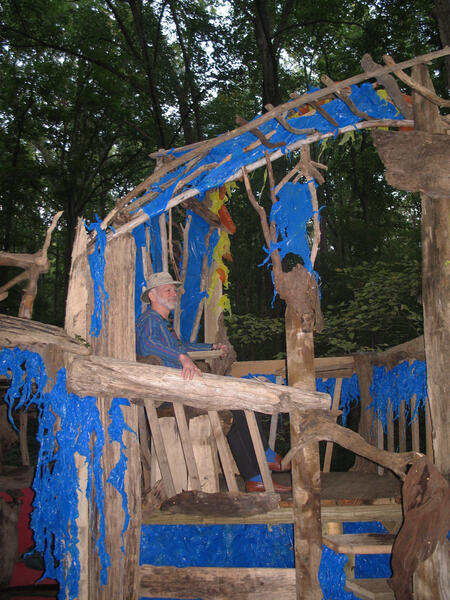 Forest House: The upper platformOn top of two intersecting walls, I constructed this platform, accessed by a stairs.
Forest House: The upper platformOn top of two intersecting walls, I constructed this platform, accessed by a stairs. -
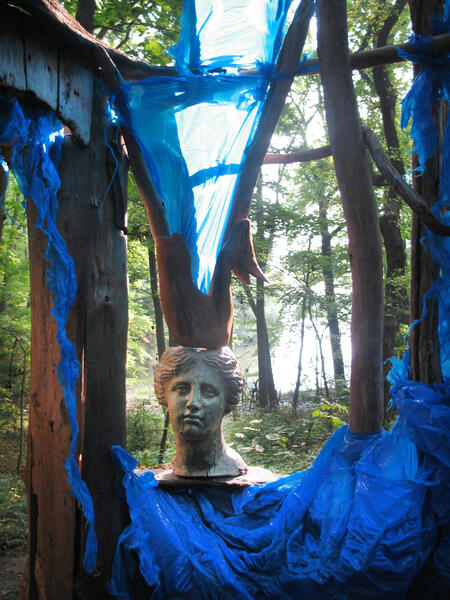 Forest House: view of the coveA donated cement bust was incorporated into the southwest corner of the installation overlooking the slope down to the cove, where waterfowl were often gathered.
Forest House: view of the coveA donated cement bust was incorporated into the southwest corner of the installation overlooking the slope down to the cove, where waterfowl were often gathered. -
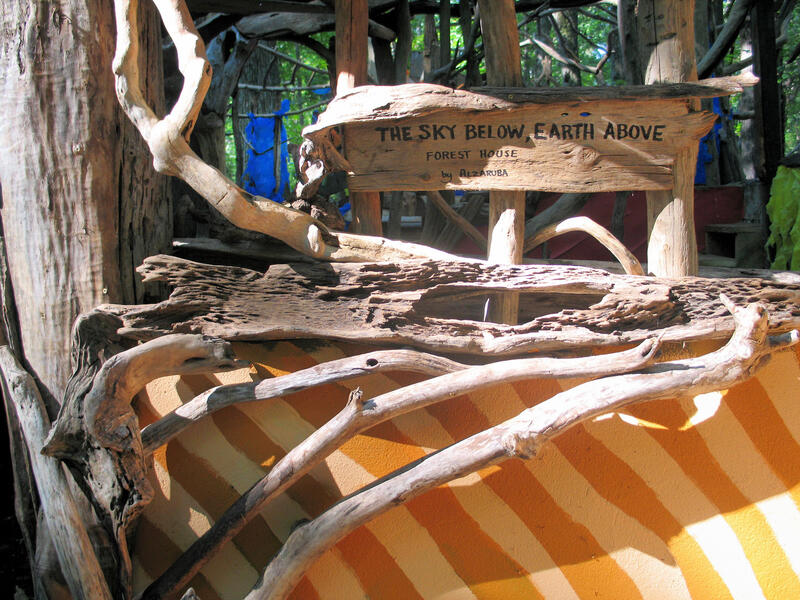 Forest HouseDetail next to the main entrance.
Forest HouseDetail next to the main entrance.
Recycled Ocean: Performance Work
This continued for a few years before I began doing solo performances independent of an installation. This was also the first time that I opened the work and invited other artists friends to participate. This led to an increasing interest in collaborations.
The majority of those performances took place in two venues. The first was during the initial seven years of the American Museum of Visionary Art, where I worked on staff. In addition to installing the exhibitions, I led off the museum's parades at their yearly festivals. The other venue was during successive Artscape festivals. Over time, I've traveled as far as Southeast Asia, performing at locations along the Mekong River, up on the Plain of Jars and at Anghor Wat.
During the year that I was a senior Fulbright scholar to Korea, (2003-04), I was invited to a series of festivals, including sold out performances at Theatre Zero, at that time a cutting edge space. I also began to develop an interest in Japanese Butoh, which led to several impromptu performances around Seoul, on the streets and in the subways. One of my primary projects was to have my performances filmed in different locations around Korea and compiled into a DVD- Inbetween.
In 2004, having returned to MICA, I organized Recycled Ocean- a performance at MICA's Falvey Hall with 16 of my students and the world fusion band, Telesma, then just beginning to be recognized. It was well received.
There are ten DVDs of various performances, from dancing among Christo's Gates in Central Park to an appearance on Maryland Public Television.
These performances have since inspired several print series. In addition the costumes have been used as suspended additions to my installations.
-
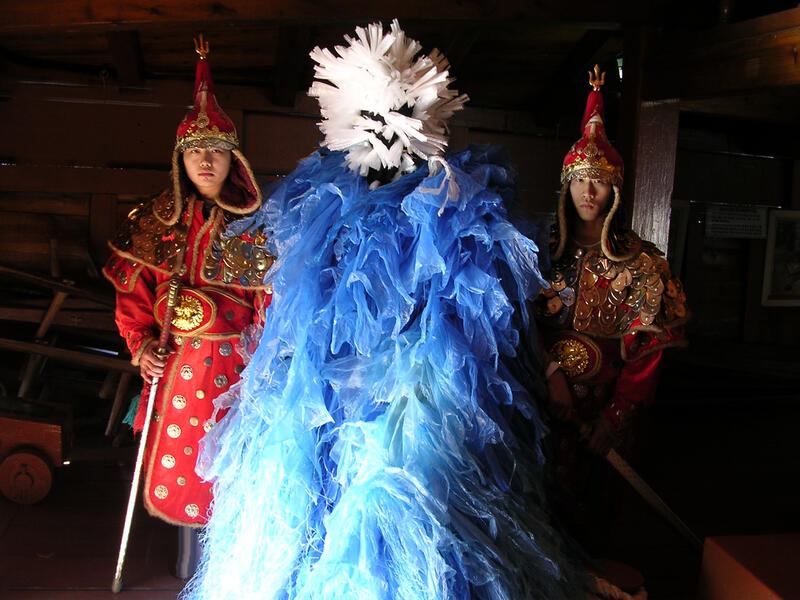 Turtleship, South KoreaA still from a performance on board a reproduction of one of Korea's historic armor-plated turtle ships, located in a naval history park on the very southern tip of the peninsula. My two assistants are wearing Naval Officer costumes from the Chosin Dynasty. The video, Inbetween, is a series of short performances and was shot in various locations around Korea, from Seoul, to the mountains and southern coasts. This image is in the catalogue.
Turtleship, South KoreaA still from a performance on board a reproduction of one of Korea's historic armor-plated turtle ships, located in a naval history park on the very southern tip of the peninsula. My two assistants are wearing Naval Officer costumes from the Chosin Dynasty. The video, Inbetween, is a series of short performances and was shot in various locations around Korea, from Seoul, to the mountains and southern coasts. This image is in the catalogue. -
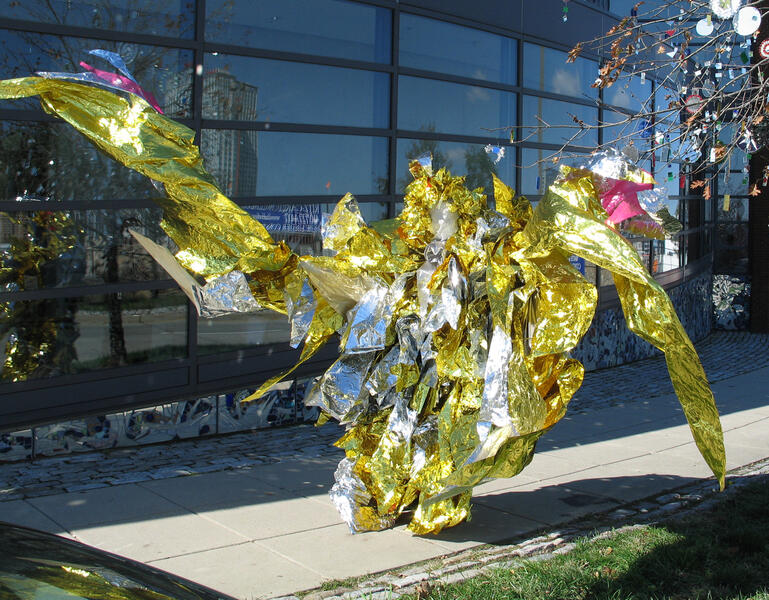 The American Museum of Visionary ArtThe gold Mylar costume used in the finale of Recycled Ocean- and shown here as a welcome to the 2006 International Fulbright Conference lunch hosted by the museum.
The American Museum of Visionary ArtThe gold Mylar costume used in the finale of Recycled Ocean- and shown here as a welcome to the 2006 International Fulbright Conference lunch hosted by the museum. -
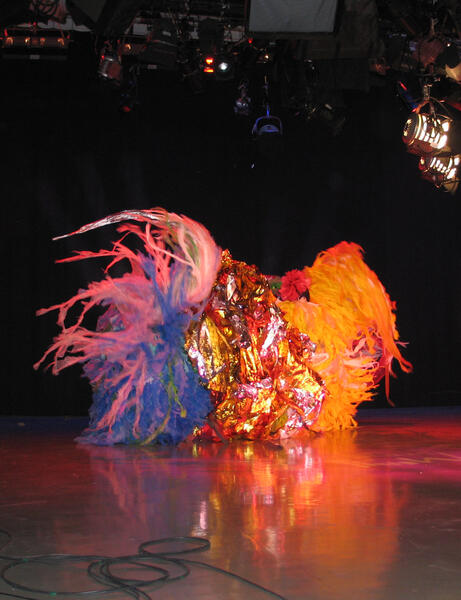 Maryland Public TelevisionArtworks this Week- #545 An impromptu performance with friends, to the sound of Telesma
Maryland Public TelevisionArtworks this Week- #545 An impromptu performance with friends, to the sound of Telesma -
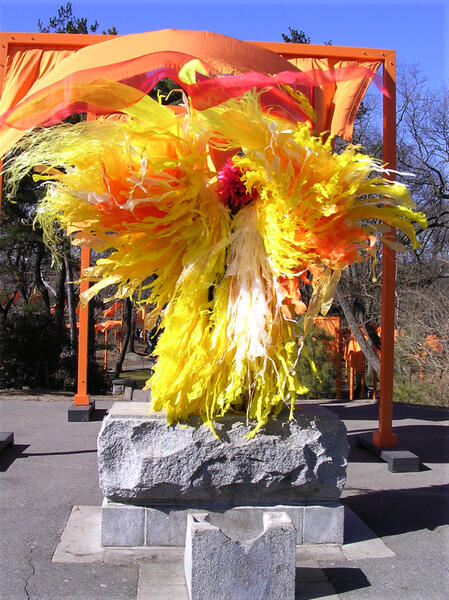 Ocean (a still)Ocean was shot amid Cristo's Gates in Central Park. The video is 30 min, with, at times, as many as seven overlapping layers. There are two versions on each DVD- words and without words.
Ocean (a still)Ocean was shot amid Cristo's Gates in Central Park. The video is 30 min, with, at times, as many as seven overlapping layers. There are two versions on each DVD- words and without words. -
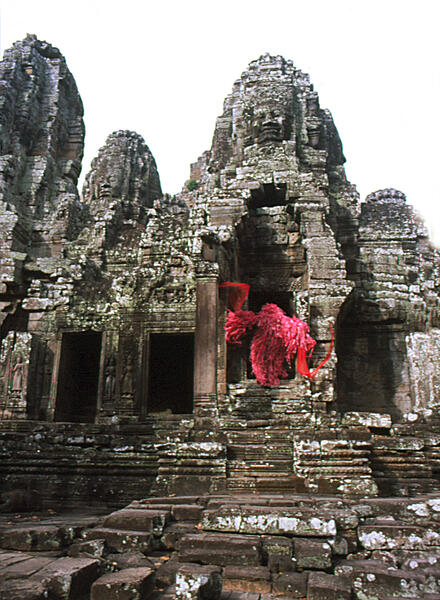 AngkhorThe Bayon, Angkor, Cambodia- 2001. I performed in a number of locations, also in Laos and along the Mekong River. A very wild time full of adventures.
AngkhorThe Bayon, Angkor, Cambodia- 2001. I performed in a number of locations, also in Laos and along the Mekong River. A very wild time full of adventures. -
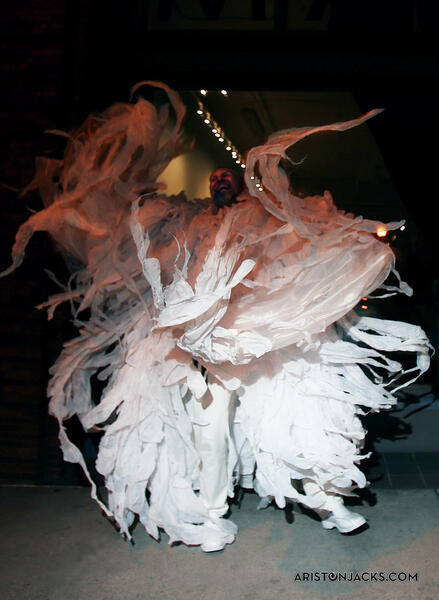 Ghost2015- Performance at Maryland Art Place. Photo by Ariston Jacks
Ghost2015- Performance at Maryland Art Place. Photo by Ariston Jacks -
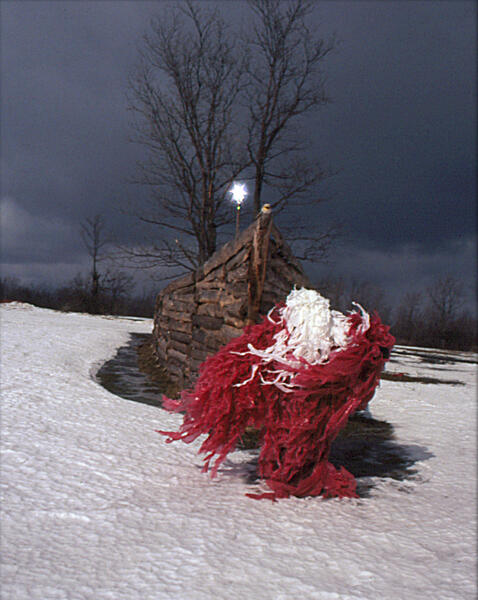 Orouri-The Scent of Light seriesThe first ship inspired many photographic experiments, most done during the evening hours and during the various seasons during it's six years of existence. This image was shot in 2004. George Maris was dancing in minus 40 degrees. 2 editions- Cybachrome- 30" x 24" edition of 3 permanent pigment gyclee 11 x 7 edition of 5
Orouri-The Scent of Light seriesThe first ship inspired many photographic experiments, most done during the evening hours and during the various seasons during it's six years of existence. This image was shot in 2004. George Maris was dancing in minus 40 degrees. 2 editions- Cybachrome- 30" x 24" edition of 3 permanent pigment gyclee 11 x 7 edition of 5 -
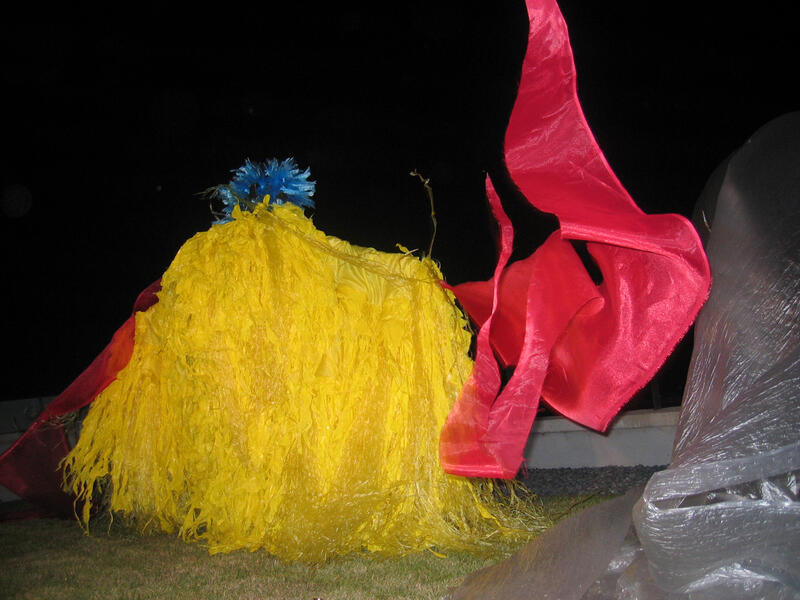 CorehandsA solo performance on the roof garden of Corehands- a cutting edge design firm in Seoul, Korea= as part of the Seoul international Performance Festival. It was a wild night- windy and a packed crowd. the edges of the rails were lined with my materials. A high point during my Fulbright in 2003.
CorehandsA solo performance on the roof garden of Corehands- a cutting edge design firm in Seoul, Korea= as part of the Seoul international Performance Festival. It was a wild night- windy and a packed crowd. the edges of the rails were lined with my materials. A high point during my Fulbright in 2003. -
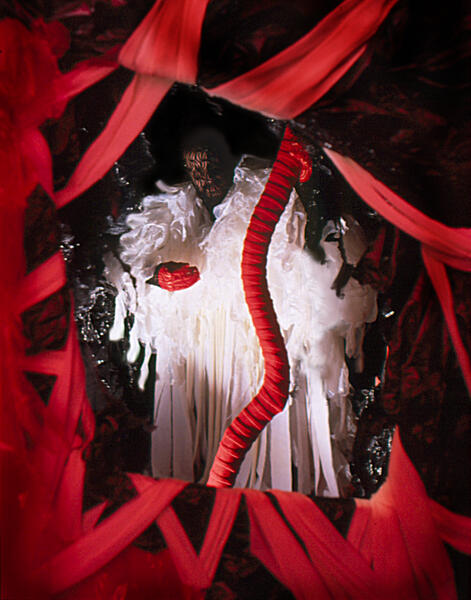 The Arbor of Unfulfilled DesireArtscape,1994- Laure Drugal's The Garden of Sublime Delerium. A 20'x20'x20' interactive installation of 8 rooms-three overhead platforms, three stairs, a black room, a white room and the rest in red, cinnamon scented shredded plastic bags being blown about by oscillating fans. Lights faded in and out on electronic relays. This inspired the creation of my first costume and performance. So, I also invited several other artists and a dance troupe to experiment with their own performance work- this was my first collaborative experience.
The Arbor of Unfulfilled DesireArtscape,1994- Laure Drugal's The Garden of Sublime Delerium. A 20'x20'x20' interactive installation of 8 rooms-three overhead platforms, three stairs, a black room, a white room and the rest in red, cinnamon scented shredded plastic bags being blown about by oscillating fans. Lights faded in and out on electronic relays. This inspired the creation of my first costume and performance. So, I also invited several other artists and a dance troupe to experiment with their own performance work- this was my first collaborative experience. -
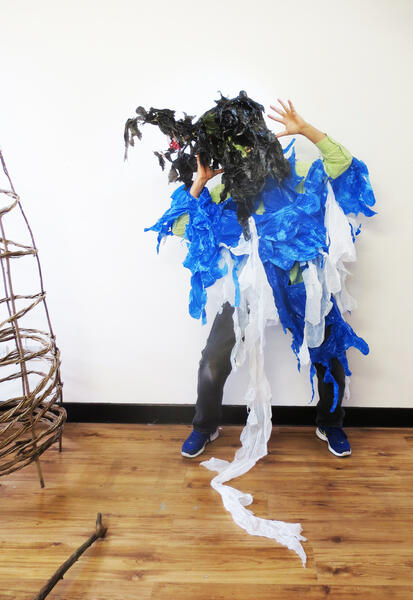 Overcome by a Hairy Doubt!The Tyrone Guthrie Centre, Ireland, June/July 2014. An informal skit during the residency that began at the dinner table.
Overcome by a Hairy Doubt!The Tyrone Guthrie Centre, Ireland, June/July 2014. An informal skit during the residency that began at the dinner table.
